- PRO Courses Guides New Tech Help Pro Expert Videos About wikiHow Pro Upgrade Sign In
- EDIT Edit this Article
- EXPLORE Tech Help Pro About Us Random Article Quizzes Request a New Article Community Dashboard This Or That Game Popular Categories Arts and Entertainment Artwork Books Movies Computers and Electronics Computers Phone Skills Technology Hacks Health Men's Health Mental Health Women's Health Relationships Dating Love Relationship Issues Hobbies and Crafts Crafts Drawing Games Education & Communication Communication Skills Personal Development Studying Personal Care and Style Fashion Hair Care Personal Hygiene Youth Personal Care School Stuff Dating All Categories Arts and Entertainment Finance and Business Home and Garden Relationship Quizzes Cars & Other Vehicles Food and Entertaining Personal Care and Style Sports and Fitness Computers and Electronics Health Pets and Animals Travel Education & Communication Hobbies and Crafts Philosophy and Religion Work World Family Life Holidays and Traditions Relationships Youth
- Browse Articles
- Learn Something New
- Quizzes Hot
- This Or That Game New
- Train Your Brain
- Explore More
- Support wikiHow
- About wikiHow
- Log in / Sign up
- Education and Communications

How to Write a TOK Essay
Last Updated: December 28, 2023
This article was co-authored by Stephanie Wong Ken, MFA . Stephanie Wong Ken is a writer based in Canada. Stephanie's writing has appeared in Joyland, Catapult, Pithead Chapel, Cosmonaut's Avenue, and other publications. She holds an MFA in Fiction and Creative Writing from Portland State University. This article has been viewed 250,759 times.
The International Baccalaureate (IB) Theory of Knowledge essay is a 1200–1600 word essay on prescribed topics or titles created by the IB. As the name suggests, your Theory of Knowledge (TOK) essay should focus on knowledge issues (what is knowledge? why and how do we know things?) and link to other areas of knowledge as well. About two-thirds of your final TOK grade is determined by your score on your TOK essay.
Choosing Your Essay Title

- Mathematics
- Natural sciences
- Human sciences
- Religious knowledge systems
- Indigenous knowledge systems

- “Compare the roles played by reason and imagination in at least two Areas of Knowledge.”
- “When mathematicians, historians and scientists say that they have explained something, are they using the word ‘explain’ in the same way?”

- Do you understand the keywords or concepts in the title? You may not be clear on what a title is asking you to do. Go through the title and highlight any words or concepts you are unsure about. Some titles will use keywords from TOK courses, such as “belief”, “knowledge” “truth”. You may want to check back on your class notes and consider what these words mean in the context of the title.
- Do you have a strong interest in the title? The title should play to your interests and you should feel you can write about the title with care and diligence. For example, if you are skilled or interested in the arts, you may choose a title like “Compare the roles played by reason and imagination in at least two Areas of Knowledge” and pick the arts as one area of knowledge. Keep in mind, however, you should balance your passion for the title with an objective perspective.
- Do you have something relevant to say about the title? It’s important that you relate the question to the ideas you have covered in your TOK course, as well as the topics you have studied in class, and your own personal experiences or thoughts. The essay should have an objective tone, but you will still need to inject it with personality, passion, and clarity.

- For example, in a title like: “When mathematicians, historians and scientists say that they have explained something, are they using the word ‘explain’ in the same way?”, you may rephrase it into two sentences. The title refers to three AOK: mathematics, history, and science. It is then asking you to compare and contrast the way these three AOK use explanation as a way of knowing about a topic or issue.
- By breaking down the title into short sentences, you now have a clearer picture of what the title is asking you to do and how you might go about answering the title sufficiently.
Structuring the Essay

- Understanding the knowledge issues: your essay must be focused on the knowledge issues, link and compare at least two knowledge issues, show relevancy between at least two knowledge issues, and demonstrate a sophisticated understanding of the knowledge issues.
- Knower’s perspective: your essay must demonstrate independent thinking, self-awareness, at least two different perspectives, and several supporting examples.
- Analysis of the knowledge issues: your essay must show insight and depth, justify your main points, present arguments and counter-arguments, and explore any assumptions and implications of your topic.
- Organization of ideas: your essay must be well structured, explain key concepts, be factually accurate, and cite references where applicable.

- You may also be asked “to what extent” or “in what way” a statement is justified. You will then need to present for and against arguments for the statement.
- If you are asked a direct question, your essay should address to what extent or in what ways you are for and against an argument or position.

- Start by doing a general, open brainstorm. Write down everything that comes to mind when you think about the title without passing judgement on any of the ideas, or stopping to read over your brainstorm.
- After five minutes of brainstorming, read over your notes. Identify ideas that relate to each other or that contradict each other. If you are evaluating or assessing a claim in the essay title, create a for column and an against column. Group your brainstorming ideas into either column. Create a third column for grey area ideas, or ambiguities, and place ideas in that column.
- Note any examples of the ideas that you wrote down. For example, you may be addressing a title like: “When mathematicians, historians and scientists say that they have explained something, are they using the word ‘explain’ in the same way?” You may create a brainstorm for each area of knowledge (mathematics, history, science) in relation to the idea of explaining something. You may then use examples of “something” that can be explained in each AOK: a mathematical equation, a historical moment in a battle or a trial, and a scientific theory.

- You should also identify the areas of knowledge you will be discussing in your essay. For example, for a title like: “Compare the roles played by reason and imagination in at least two Areas of Knowledge” you may choose two AOK: the arts and science. You may then compare and contrast the function of “reason” and “imagination” in the arts and in science.

- Paragraph 1: Introduction. You would provide an explanation and interpretation of the title and identify the key terms in the title. You would also state your thesis and explain or identify a knowledge issue related to the title.
- Paragraph 2: First Area of Knowledge. For example, the arts. Discuss how the arts answers the title and provide supporting examples. You should also note any counter-arguments against the title or any limitations of the supporting examples.
- Paragraph 3: Second Area of Knowledge. For example, mathematics. Note how mathematics answers the title and provide supporting examples. You should also note any counter-arguments against the title or any limitations of the supporting examples.
- Paragraph 4: Third Area of Knowledge (if applicable)
- Paragraph 5: Conclusion. Summarize your main ideas and restate your thesis. Conclude by answering the title fully, taking into account the counter arguments and limitations of the areas of knowledge.
- You may also decide to structure your essay based on a main argument and a main counter-argument. Your outline may contain four paragraphs total:
- Paragraph 1: Introduction and explanation of the knowledge issue.
- Paragraph 2: Main argument, with justification and one to two supporting examples.
- Paragraph 3: Main counter-argument, with justification and one to two supporting examples.
- Paragraph 4: Conclusion.

- Some students find it useful to draft their thesis statement once they have finished writing a first draft of the essay. By this point, you will likely have a better sense of the main arguments in the essay and be able to write a clear, concise thesis statement.
- For example, you may need to create a thesis statement for this title: “Compare the roles played by reason and imagination in at least two Areas of Knowledge.” You have chosen two AOK: the arts and mathematics. Consider how reason and imagination function in the arts and in mathematics, as well as the different ways they function in each AOK. Your thesis may be: “Through reason and imagination play an important role in both mathematics and the arts, the imaginative thoughts of mathematicians must be provable, while the imaginative thoughts of artists need only be reasonable.” [5] X Research source
Writing the Essay

- You may want to also refer back to your brainstorming notes to identify the supporting examples for your two areas of knowledge, or your main argument and your main counter-argument.

- For example, you may be discussing the use of reason and imagination in the arts. Rather than discuss a familiar artist, like Picasso, or a familiar example of imaginative thinking, like the Sistine Chapel, use supporting examples that feel original and insightful. Though the essay should be objective in nature, it should also feel reflective and personal. Using a supporting example that you feel passionate about, like Pollack’s kinetic movement paintings, or Rodin’s sculptures, will show you have taken the time to explore unique examples.

- Reference surprising or little known claims, but not well known facts or commonly held opinions. For example: “The sun is the center of the solar system” is a well known fact you will not need to cite. But “Rodin was a traditionally-schooled artist and had a craftsman-like approach to his work” will require a citation as it is maybe a little known fact.
- Reference any sentences or sections where you are closely following someone else’s train of thought or argument, even in your own words.
- Reference exact quotes, and use quotation marks.
- Be consistent with your citations and the way you reference certain sources.

- As you read your essay out loud, make sure there are no vague or abstract sentences or terms. You want to ensure you use your 1600 word count in a clear and concise way. Every word will count in your TOK essay.
- Confirm you have addressed knowledge issues in your essay. Your essay should answer the question “How do you know?” and assess the strengths and weaknesses of knowledge claims in at least two areas of knowledge. You should also use arguments and counter-arguments to support your thesis statement, as well as strong supporting examples.

Community Q&A
You Might Also Like

- ↑ http://www.dirk-solies.de/TOK/how%20to%20write%20a%20ToK%20essay%20cambridge.pdf
- ↑ http://www.toktalk.net/2009/11/20/starting-and-planning-the-tok-essay/
About This Article

To write a TOK essay that compares several areas of knowledge, start with an introductory paragraph that explains your title and states your thesis. Then, write 2-3 main body paragraphs, discussing in each a single area of knowledge and how it relates to your title. Try to provide supporting examples in each case, and address any potential counter-arguments, as well. Finally, end your essay with a conclusion that summarizes your main ideas and restates your thesis. When you’re done, check to be sure that you’re within the 1,200-1,600 word limit for the essay. To learn from our English reviewer how to choose an essay title and create your thesis statement, read on! Did this summary help you? Yes No
- Send fan mail to authors
Reader Success Stories
Sep 28, 2018
Did this article help you?
Dianna Riley
Jan 10, 2017
Roman Nahum
Jan 16, 2017
Apr 6, 2017

Featured Articles

Trending Articles

Watch Articles

- Terms of Use
- Privacy Policy
- Do Not Sell or Share My Info
- Not Selling Info
wikiHow Tech Help Pro:
Level up your tech skills and stay ahead of the curve
How To Write A ToK Essay - Updated 2023
Ace your ToK Essay with our expert tips & tricks! Get the latest and greatest techniques on "How To Write A ToK Essay" and impress the IB examiners.📝💡

Table of content
Purpose of tok, assessment of tok, the game plan, execution of the gameplan, planning for tok essay, structure of tok essay, introduction, conclusions, bibliography.
How to write a TOK Essay?
To answer that, you must familiarise yourself with what a TOK Essay is about.
Before you start reading this article, Amanda has some excellent TOK tips for you!
Theory of Knowledge is one of the most meta subjects that IB offers. Despite its complexity, TOK helps in providing a base for holistic learning and allows students to have a multidisciplinary experience.
To understand TOK is to understand the essence of IB, a task that most people consider unattainable.
But not for you!
Thank your lucky stars who made you land on Nail IB. How exactly will Nail IB help you?
Well, nailing International Baccalaureate is something we will discuss later.
Let's focus on cracking your TOK essay, shall we?
TOK demonstrates how students can apply their knowledge with greater awareness and credibility .
Big words, huh?
Now that we know that we cannot just slide through the Theory of Knowledge, let's understand how we can conquer this battle all guns blazing.
ToK essay’s primary objective is to answer the why behind our studies.
It makes one aware of the real-life implications of their subjects. The students gain greater awareness of their personal and ideological assumptions and appreciate the diversity of different perspectives. It helps the students find their unique perception, a prerequisite for excelling in the IB TOK essays.
Before we dive into our gameplan, let’s overview the rules of the game.
There are two assessment tasks in the TOK: an essay and a presentation . While a presentation encourages students to explore a real-life situation through the lens of TOK, an essay is written on the basis of the various questions provided by the International Baccalaureate Organisation.
- The presentation is to assess a student’s ability to apply TOK thinking to a real-life situation whereas IB TOK essay is more conceptual.
- The essay is externally assessed by IB and must be on any one of the prescribed TOK essay titles issued by the IB for each examination session.
- Word limit of a TOK essay is 1600 words ( excludes extended notes, footnotes, bibliography).
Now that we have unleashed the game, let’s move ahead towards the gameplan of acing both, your presentation and your essay.
One of the fundamental tasks of TOK is to examine different areas of knowledge and find out their similarities and differences.
The TOK essay requires the students to investigate two Areas of Knowledge (AOK) and two Ways of Knowing (WOK) . AOKs and WOKs are investigated via questions such as:
- How do we know what we know? (WOK)
- What counts as evidence for X? (AOK)
- How do we judge which is the best model of Y? (WOK)
- What does theory Z mean in the real world? (AOK + WOK)
The aforementioned are Knowledge Questions which help combine the Areas of Knowledge and the Ways of Knowing that they are using. This eliminates the superficial way of learning and makes an individual sensitive to the nature of the information. Our acquisition of Knowledge can be broadly divided into Shared Knowledge and Personal Knowledge.
Shared knowledge: What WE know It is the product of more than one individual. Although individuals contribute to it, shared knowledge does not solely depend upon the contributions of a particular individual—there are possibilities for others to check and amend individual contributions and add to the body of knowledge that already exists.
Personal knowledge: What I know It is essentially dependent on the experiences of a particular individual. Also known as procedural knowledge, it is gained through experience, practice and personal involvement and is intimately bound up with the particular local circumstances of the individual such as biography, interests, values, and so on.
The best hack to ace TOK essay is to develop a habit of making connections between the construction of knowledge, its acquisition and its relevance in the real world.
After that one needs to develop an interest in understanding the difference between diversity and cultural perspectives and personal assumptions.
One also needs to critically reflect on their own beliefs and assumptions, leading to more thoughtful, responsible and purposeful lives.
Yes, this is what you signed up for. It may sound a little intimidating but once you get the hang of it you will be able to see the matrix and understand this beautiful world a little better.
Understand that to provide the best version of your writing, it will take you more than one or two drafts. First and foremost, you need to pick your essay topic diligently. Try to choose an essay topic that best interests you. The topic should also allow you to explore the Areas of Knowledge towards which you are naturally inclined. Here are a few sample questions:
a) 'Ways of knowing are a check on our instinctive judgments.' To what extend do you agree with this statement?
b) With reference to two areas of knowledge discuss the way in which shared knowledge can shape their personal knowledge.
c) How can we know if knowledge is produced more through 'Passive Observation' or 'Active-Experiment' within the Human and Natural-sciences under a Mathematical-Perspective?
d) "The whole point of knowledge is to produce both meaning and purpose in our personal lives". Assess the validity of this statement.
Great things take time. It took me more than a couple of weeks to finalize this TOK essay guide. It is completely okay if the first few drafts may not look pleasing or award-winning to you. You will require sharpening your perspective towards the topic each time you polish your draft. Your writing journey from a dull draft to a masterpiece will be a whole process that you will have to be patient with. Have faith in yourself and proceed stepwise.
You need to consider the opinions of others who have devoted hours of research and a lifetime of dedicated studying the topic that surrounds your writing. Unravelling the realms of your mind palace is so Sherlock but let’s not deny the fact that at times, Watson is the one whose expertise helps Sherlock through pretty difficult times. I mean even Batman needs a Robin. In support of my awesome sauce examples, the point I am trying to make is that finding support for our claims and counterclaims through research is a good thing .
Use real-life examples to support your claims and counterclaims. These examples need to be documented researched examples like studies, experiments, articles, presentations by well-known people, etc. Examples that stem from your diploma subjects are highly encouraged, but those will need to be supported by research as well.
It is suggested that you choose a title, stick to it, tackle it and not be afraid. Do not change your mind unless there is a good reason. Also, try choosing Areas of knowledge that you truly enjoy. You know slaying a known devil is much easier than an unknown one. Allot a TIMELINE to your essay. Start with creating an outline of your essay. This will help you to track your progress and accomplish your goals
You can use tools like Trello to organize your ideas and plan your TOK essay.
Areas of Knowledge (AOKs): TOK distinguishes between eight areas of knowledge. They are mathematics, the natural sciences, the human sciences, the arts, history, ethics, religious knowledge systems, and indigenous knowledge systems. It is suggested that students study and explore six of these eight.
Ways of knowing (WOKs): TOK identifies eight specific WOKs- language, sense perception, emotion, reason, imagination, faith, intuition, and memory. It is suggested that studying four of these eight in-depth would be appropriate. WOKs underlie the methodology of the areas of knowledge and provide a basis for personal knowledge.
Moving ahead, let us discuss the structure of your TOK essay.
Your essay will consist of 4 broad segregations
Before breaking down further on the pillars, keep the following in mind
- Please note what the TOK essay title is asking you. (Read it a couple of times. We highly recommend that you brainstorm ideas with your TOK coordinator)
- Make sure you understand the command term and the question it is asking.
- What kind of knowledge is being elicited?
- When choosing your areas of knowledge (AoK) and ways of knowing (WoK) make sure that you are able to draw contrasts and comparisons, that is, you are able to find evidence that supports as well as challenges your claims.
- Identify key terms in your TOK essay title. Make sure you define them. Your essay will gravitate around them. Key terms/words in your titles are your essay anchors. Your response should be built around them.
- Your writing skills come in handy while you work on your IB TOK essay. Like any other essay make sure you have proper thesis statements and topic sentences to guide the evaluator through your work.
- Respect the TOK essay title. Rephrasing the topic is not encouraged . Your main job is to address the title.
Introduce your topic accurately and state your thesis statement for the essay carefully. A thesis statement is like a teaser to your entire essay wherein you define your key terms and introduce your interpretation of the question. Make sure that you do not reword the prescribed title in your thesis. Instead, it needs to, as the word says, INTRODUCE your readers to what your essay is about. A strong introduction allows the reader to deduce what knowledge question(s) you are trying to answer.
So, in a nutshell
- Write interesting things about the given TOK essay title .
- Define key terms
- Narrow in on the particularly interesting aspect
- State your thesis statement . This will be your short answer to your given title if you don't know how to write a killer thesis statement check out this blog from SparkNotes .
- State your Roadmap. This will help the readers in understanding the direction of your essay.
The body can be mainly divided into 3 segments.
Body (1st Segment)
- AoK Claim: Here you investigate your first Area of Knowledge and draw parallels between your AoK and the question. This is done by stating your claim. Claims can be general in nature and need not reference a particular area of knowledge. They help you shape your essay and investigate the question further.
- Evidence: Example of a real-life situation, describe thoroughly and accurately, which supports your stated claim. (AoK)
- Counter-Claim: State your counter-claim: like claims, those can be general and need not reference a particular area of knowledge. Counterclaim helps you show the other side the coin and gives your essay a holistic nature.
- Evidence: A referenced real-life situation/example. Describe thoroughly and accurately, show how this supports your counterclaim (AoK ).
- Don’t forget to weave in your WoKs: You need to take into account the source of your knowledge. Here you can also investigate if your nature of acquiring the knowledge has, in any way, affected it. It is good practice to question if your knowledge would be different had it been acquired through a different source/method
- Mini-conclusion: Here you analyze your examples in reference to your claims and counterclaims. You must connect to your thesis statement and the prescribed title. How does your proposed argument, in this particular part of the body, connect to the prescribed title and the knowledge questions you are trying to answer?
Body (2): Follow the above process for your second AOK.
- Use this part of your essay to compare and contrast your varying AoKs. You need to connect them to your thesis and your prescribed title clearly showing how your arguments respond to the PT.
Your conclusion section will make your essay come together. It is the glue that will make your essay stick together. Herein, you need to
- Reiterate your thesis (initial response).
- Use your mini conclusions to write a final conclusion.
- Tell the reader what the significance is for knowing what we know in this particular PT.
- Discuss implications as well.
- Offer another perspective, how will the perspective of a different person affect the claims/counterclaims you make in the essay?
- Don’t forget to make the end strong.
We recommend all the ib students use the citation machine (It's FREE) to organize or generate a bibliography for your TOK essay. Please go through this extensive guide provided by the IB before you start working on your citations.
If you are still struggling heaps with your TOK essay feel free to subscribe to our tok notes bundles or get access to more than 500+ IBDP notes and past papers here .
Nail IB is your virtual companion that helps you hustle through your diploma and provide you with the right resources at the right time. To know more about acing IB, click here .
I hope this article will become the foundation for figuring out how to write a TOK Essay.
Remember to have faith in yourself.
I hope you NAIL your TOK essay!
Quoting the great Napolean Hill
"Whatever the mind of a man can conceive and believe, it can achieve."
IB Resources you will love!
Nan + free ib flashcards, -1 + free ia samples, nan + ib videos by experts, -1 + ib sample practice questions, ib resources for nan + subjects.
What are your chances of acceptance?
Calculate for all schools, your chance of acceptance.
Your chancing factors
Extracurriculars.
Guide to the TOK Essay
What’s covered:.
- What is Theory of Knowledge (TOK)?
- What is the Theory of Knowledge Essay?
How is the Theory of Knowledge Essay Scored?
How to structure your theory of knowledge essay.
The International Baccalaureate Diploma Programme (IB/IBDP) is a rigorous and rewarding internationally based educational program that offers courses in numerous studies, from humanities to chemistry. Students take part in a two-year curriculum that includes external examinations, internal assessments, research papers and community service hours. Essentially, students will have to do a bit of everything, especially with IB’s core, which is CAS, TOK, and the extended essay (EE). Understanding how TOK, IB’s flagship class, is assessed with its essay is important to success in the course overall.
What is Theory Of Knowledge (TOK)?
Theory of Knowledge is IB’s way of introducing a more intuitive way of thinking into classrooms. TOK is at its surface as simple as it sounds: you essentially learn the “what” and “why” of how we learn and understand knowledge. In order to assess students of their skills in TOK, IB uses an essay and a presentation. The essay makes up 67% of your total TOK score, making it the most important task to focus on for getting a high score.
What is the Theory Of Knowledge Essay?
The TOK essay is a 1600 word essay written about topics usually given to students from their teachers from a list of numerous options. It is an essay that promotes arguments and counterarguments for the topic at hand. Understanding your ways of knowing (WOKs) and areas of knowledge (AOKs) is extremely crucial before you even start choosing a topic to write on, as your essay will revolve around and structure itself based on these two concepts. Being able to demonstrate higher-level thinking and using examples to solidify the points you make in your essay is also important. Additionally, you’ll need to reference every source of information that you use, since that is something examiners look for as well.
As said earlier, 67% of your grade is from the essay, and your overall TOK score receives a letter grade using a calculated score out of thirty. Your essay score and presentation score are each out of ten. The grades for your TOK presentation and essay are determined by sending material to the board of IB, from which they designate a grader/examiner to read your essay and grade based on a rubric that determines the level of knowledge you exhibit in your writing.
The following formula should better explain how to find your TOK grade.
(presentation score) + (essay score * 2) = overall score out of 30
The grade boundaries out of 30 that determine your letter grade can vary each year so checking in with your school for the most recent ones is the best course of action, but an example set would be like this:
Once you have a letter grade for IB, your extended essay, which is another part of the core, is also included into a larger grading schema to calculate your core score, which is three additional points required to complete and earn the diploma. The following table details this grade further:
Doing well in the core is important to passing IB and getting three points out of the total 45 attainable points.
There’s a trick that most IB students use in writing the TOK essay, and it boils down to understanding four key components of learning:
- Content : Understanding knowledge issues
- Clarity : Structuring your essay in a legible and clear/easy to read manner
- Creativity : Using your personal ways of thinking and applications of knowledge specific to your understanding of the knowledge issue
- Critical Thinking : Using a counter argument for every argument you have to analyze your own claims constantly
Dividing your actual essay into three main chunks helps, starting with an introduction. Your introduction should be where you state your knowledge question, the central point of your essay, and you should make use of jargon specific to the concept. As the basis of your essay, the introduction should be where you form claims and counterclaims that either support or challenge the knowledge question through heavy analysis and evaluation.
The body of the essay follows the introduction, and it is where most of the conceptual analysis of your knowledge question takes place. Every argument and its counterargument should have a dedicated paragraph of its own, and make sure to not jump back and forth too much throughout the essay. to avoid creating messy transitions for the reader and potentially harming your score. Understanding the essay from the reader’s point of view is important, as it will help you better understand how to structure the body of your essay.
A conclusion in the TOK essay is mainly for finding closure among the numerous arguments that have been taking place thus far in the essay. Make sure to summarize but not repeat previous information entirely to refresh the reader. A conclusion should essentially loop back to the beginning of the essay, the knowledge question. The knowledge question’s answer should be the conclusion and the stopping point of the essay, and by now the answer you provide should be backed by paragraphs of supporting claims and counterclaims. If done right, concluding the essay can be how you earn most of your points.
Start Early
Starting early is an obvious and effective advantage to students. Aside from TOK, let alone the presentation, IB has substantial work that requires focus and allocated time dedicated to it, such as external examinations and the extended essay. These tasks are equally as important as the TOK essay, so starting your outlining, drafting or even just planning early will set you up for success.
Send Your Drafts to Your Teacher
Your TOK teacher is a great resource for drafting essays and making edits to perfect your final product. Making use of time outside of the classroom to catch your teacher for a quick review of your essay could be a bigger advantage than you realize. Making use of an outside perspective is essential to forming a great essay.
While your final IB grade isn’t as important as you’d think regarding college admissions, understanding how to pass TOK and using the lifelong practices you’ll learn in the class is even more important. TOK creates students who think outside conventional methods, making them excellent candidates in the eyes of college admissions offices. Taking TOK and showing proof of understanding it as well as capability of academic rigor is what colleges are looking for. For more information on how your chances of college admissions might look, use CollegeVine’s admissions calculator !
Related CollegeVine Blog Posts

Example essays
As part of theory of knowledge (TOK), each student chooses one essay title from six issued by International Baccalaureate®(IB).
The titles change in each examination session.
Upcoming and past questions include:
- “To what extent are areas of knowledge shaped by their past? Consider with reference to two areas of knowledge.”
- “'There is no reason why we cannot link facts and theories across disciplines and create a common groundwork of explanation.' To what extent do you agree with this statement?”
- “There is no such thing as a neutral question. Evaluate this statement with reference to two areas of knowledge.”
- “'The task of history is the discovering of the constant and universal principles of human nature.' To what extent are history and one other area of knowledge successful in this task?”
Further guidance on the TOK essay and exhibition can be found in the IB’s Programme Resource Centre (PRC) .
Materials in the PRC are only available to existing IB World Schools. These materials are free.
There are a number of resources on TOK in the IB Store , which are available to everyone.
Find out how to become an IB World School .

We use cookies on this site. By continuing to use this website, you consent to our use of these cookies. Read more about cookies
Extended Essay Writers

How to Structure the TOK Essay?

Luke MacQuoid
Hello, fellow IB students! Fear not if you’re struggling with the IB Theory of Knowledge essay. I’m here to guide you through writing a stellar work. Having been in your shoes and now a seasoned IB writer, I understand how daunting this task can feel. But let’s break it down together. In this article, I’ll share insights on how to structure the TOK essay, a skill I’ve honed over years of experience.
Fundamentals of TOK Essay Structure
Let’s dig into the TOK essay structure, an essential aspect of successful IB essay writing. In my view, understanding the basic structure is like having a guide for your academic paper. So, a typical TOK essay includes three main parts.
The introduction is where you set the stage. It’s about introducing your topic and presenting your thesis statement — your central argument or standpoint. A strong introduction captures the reader’s attention and clearly outlines what you will discuss.
The body of your essay is where the discussion takes place. Each paragraph should focus on a specific aspect of your thesis. Here’s a simple breakdown:
- Point . Start with a clear point that relates to your thesis.
- Explanation . Elaborate on this point. Why is it relevant? How does it relate to the TOK concepts ?
- Example . Provide examples to support your point. It could be real-life situations, specific knowledge claims, or references to areas of knowledge.
- Analysis . Analyze your example; don’t just describe it. How does it support your argument? What implications does it have for knowledge?
In the conclusion, you’re wrapping up your essay. Restate your thesis in a new light, considering the arguments and examples you’ve presented. It’s your final chance to make an impact on your reader, so make it count by summarizing your main points and leaving them with a final thought or question to ponder.
Remember, while the structure is like a skeleton, how you articulate your arguments, provide evidence, and engage with TOK concepts breathes life into your essay. Keep your writing clear, coherent, and focused on your thesis throughout.
How to Choose the Right Title for Your TOK Essay?
Selecting the appropriate title for your TOK essay is a significant step. From my extensive experience writing and mentoring in the IB program, I can tell you that your chosen title sets the tone for your essay. It’s not just a label; it’s the guiding star of your argument.
When faced with the list of prescribed titles from the IB, take your time to reflect on each one thoroughly. Which of these titles sparks your curiosity or challenges your thinking? The right title should resonate with your interests and knowledge. Here’s why this is crucial:
- Personal Engagement . A title that genuinely interests you will inspire deeper thought and more passionate writing. Your connection to the topic will shine through in your essay, making it more compelling.
- Scope for Exploration . Consider how the title allows for the exploration of TOK concepts. A good title should offer enough breadth to discuss various perspectives and areas of knowledge yet be specific enough to allow for in-depth analysis.
- Connect with Areas of Knowledge . Consider how the titles relate to different areas of knowledge (AOKs) and ways of knowing (WOKs). Choose a title that allows you to draw on the AoKs and WOKs you are most familiar with or find most intriguing.
- Formulate Your Argument . A well-chosen title will help you formulate a clear and concise thesis statement and meet a TOK essay word count . It should offer a clear path to build your arguments upon.
The title of your TOK essay is more than just a starting point; it’s the framework upon which your entire argument is built. Take the time to choose wisely, and ensure it’s a title you can engage deeply and critically. This careful consideration at the beginning significantly affects the ease of writing and the quality of your final essay.
Writing a Captivating Introduction for Your TOK Essay
Writing an introduction for your TOK essay is like setting the stage. It’s your first impression on your reader and, more importantly, the examiner. Having guided many students through this process, I’ve learned that the introduction is not just about stating facts; it’s about engaging, intriguing, and presenting your stance. Your introduction should serve several key purposes.
Present Your Thesis Statement
It is the cornerstone of your essay. Your thesis statement should clearly state your perspective or argument to the TOK title. It must be concise yet powerful, giving the reader a clear sense of your viewpoint and how you intend to research it.
Interpret the Essay Title
Before digging into your argument, you must show you’ve thought deeply about the title. Explain the title and hint at the angles you will research. It sets the context for your argument and shows the examiner that you’re addressing the title directly.
Outline Your Approach
Give the reader a map of your essay. What aspects will you cover? How will you approach them? It doesn’t mean listing every point you’ll make but giving a general idea of the structure and flow of your argument.
Engage the Reader
The introduction is also about capturing the reader’s interest. Start with an intriguing statement, a thought-provoking question, or a compelling quote. It can be a great way to draw the reader into your discussion.
Connect to TOK Concepts
Briefly indicate how your essay will engage with key TOK concepts. It could include the areas of knowledge you will focus on or the ways of knowing that will be most significant in your analysis.

Structuring the Body of Your TOK Essay
This part of the TOK essay is where you develop your ideas, present evidence, and conduct a thorough analysis. Here’s a comprehensive guide to writing the body of your TOK essay.
Paragraph Organization
Start each paragraph with a clear topic sentence related to your thesis. This sentence should introduce the paragraph’s main idea, clearly linking your argument. Each section must focus on a single main idea to maintain clarity and coherence.
Develop Ideas
After introducing the main idea, it’s time to develop it. It involves explaining your point in more detail, relating it to TOK concepts, and showing how it supports your thesis. Be sure to include your insights and understanding. Your engagement with the topic is what brings your essay to life.
Use Evidence
Each point you make should be supported by evidence. It could be real-life situations, historical examples, science, literature, or personal experiences. What’s important is that your examples are relevant and help to substantiate your argument.
Critical Analysis
Don’t just present evidence; analyze it. Discuss its implications, strengths, and weaknesses. How does it support your point? What does it say about knowledge? This analysis demonstrates your critical thinking skills and depth of understanding.
Ensure that your paragraphs are interconnected. The end of each paragraph should naturally lead to the beginning of the next. This can be achieved through transition sentences summarizing one point and hinting at the next or directly linking the concepts discussed in consecutive paragraphs.
Reflect on Counterarguments
In your body paragraphs, it’s also effective to consider counterarguments or alternative perspectives. It shows the breadth of your understanding and strengthens your argument by demonstrating that you have considered and rebutted opposing views.
How to Add Real-Life Examples to Your TOK Essay?
When selecting examples, ensure they directly illuminate the point you’re making. The beauty of TOK is its interdisciplinary nature, so draw various areas like history, science, current events, or even personal experiences. This variety demonstrates your broad understanding of knowledge across different fields.
However, it’s not just about listing examples. The art lies in how you link them to TOK concepts. Each example should be a tool to explore these concepts, shedding light on your argument. It’s essential to analyze your examples, discussing their implications and relevance to the essay question. This approach shows critical thinking and a deep engagement with the material.
Also, consider the limitations of your examples. Acknowledging potential biases or missing perspectives reflects your ability to evaluate knowledge claims from multiple angles critically. Smoothly integrating these examples into your essay improves its flow and coherence, making your arguments more compelling. Remember, effective use of real-life examples can turn a good TOK essay into a great one.

Need help with your IB TOK essay?
From research and analysis to structuring and editing, our skilled mentors will be by your side, helping you write an exceptional TOK essay that meets the word count and stringent IB criteria.
Making Conclusion for Your TOK Essay
The conclusion of your TOK essay is much more than just a summary. It’s your final opportunity to make an impact. Drawing from my extensive experience in IB writing and mentoring, I can give some key elements to include.
Synthesize Key Points
Your conclusion should summarize the main points you’ve made. It isn’t about listing each point again but about drawing connections between them to reinforce how they collectively support your thesis. Show the reader how the pieces fit together.
Address the Implications
Discuss the broader implications of your argument. What does your analysis suggest about the nature of knowledge? How does it contribute to our understanding of the TOK themes? It’s your chance to demonstrate the significance of your discussion beyond the confines of the essay.
Reflect on AOKs and WOKs
Briefly reflect on how your essay engages with different areas of knowledge and ways of knowing. How have these contributed to your understanding of the topic? This reflection shows your ability to think about knowledge holistically and interconnectedly.
Leave Thought-Provoking Idea
End your essay with a thought-provoking idea or question. It could be related to a gap in the current understanding, a future direction for research , or a philosophical question that emerged from your discussion. The goal is to leave the reader thinking deeply about the topic even after reading.
The Bottom Line
And there you have it! A guide on how to structure the TOK essay. Remember, this is your opportunity to showcase your critical thinking skills. With a clear structure and a bit of creativity, you’re well on your way to success. Best of luck, and remember that our experts are always ready to help you with TOK essay writing.
Luke MacQuoid has extensive experience teaching English as a foreign language in Japan, having worked with students of all ages for over 12 years. Currently, he is teaching at the tertiary level. Luke holds a BA from the University of Sussex and an MA in TESOL from Lancaster University, both located in England. As well to his work as an IB Examiner and Master Tutor, Luke also enjoys sharing his experiences and insights with others through writing articles for various websites, including extendedessaywriters.com blog

Leave a Reply Cancel reply
Your email address will not be published. Required fields are marked *
Save my name, email, and website in this browser for the next time I comment.
TOK RESOURCE.ORG
Tok endgame: tok essay essentials.

Kafka overcoming writer's block by Robert Crumb
GETTING STARTED
Guide students through this page of TOK Essay essentials before plunging into the planning and writing process using the TOK Essay strategy. In the spirit of “doing and experiencing,” the classroom activities on this page will ensure a close encounter with the formal expectations and rubric.
RITE OF PASSAGE
The student-friendly Exhibition , undertaken during the first year of the course, is good preparation for the TOK Essay which, like the Extended Essay, is a culminating rite of passage for all Diploma students in their final year. It is suggested that ten teaching hours are devoted to working on the Essay. Prescribed titles are released six months before the submission deadline. They can be downloaded from the My IB portal and shared ceremoniously with your students.
By design the Exhibition is rooted in the Core and Optional Themes. The Essay emphasizes Areas of Knowledge.
CLASS ACTIVITY i: SETTING THE FRAME—ESSAY ESSENTIALS
Begin by setting out the expectations unambiguously. Tell students that TOK essay is a “formal, sustained piece of writing” in response to one of six prescribed titles. It is externally assessed, with twice the weighting of the Exhibition.
Here are the perennial conventions for the essay:
1. Title must be used “exactly as given”
2. Standard 12 size font—double spaced
3. Sources must be acknowledged
4. Maximum word count is 1600* words .
*The word count includes the main body of the essay including quotations. It does not include the title or references (whether given in footnotes, endnotes or in-text) and/or bibliography.
THREE TEACHER INTERVENTIONS
A close reading of the TOK Subject Guide on teacher guidance and the imperative to ensure authenticity is essential reading for the teacher. It declares that:
The TOK essay must be the student’s own work. However, the teacher plays an important role in supporting the student during the planning and writing of their essay. Teachers are expected to explain the requirements of the task and ensure that students are familiar with the assessment instrument, provide clarifications in response to students’ questions, monitor students’ progress, and check the authenticity of the student work.
During my own time as a TOK examiner, grading hundreds of randomly selected essays from all over the world, it was very often obvious when a teacher had, for whatever reason (including, no doubt, student procrastination until the very last moment), taken a completely hands off approach, and left a weaker student to sink or swim. Over the years some very precise guidelines for the role of the teacher in preparation and planning have evolved.
Three mandated formal interactions between the student and teacher are recorded on the Planning and Progress Form (TK/PPF) :
1. Discuss the list of prescribed titles with the student.
2. Discuss the student’s initial exploration of their selected title
3. Comment on one draft of the student’s essay.
CLASS ACTIVITY II: GRADING IB EXEMPLARS WITH THE RUBRIC
The final piece for setting up students for success in the Essay is providing a close encounter with the official assessment rubric. Here is a convenient Google Doc version of the Rubric. Emphasize the “single driving question” that underpins the five levels of performance defined in the rubric:
Does the student provide a clear, coherent and critical exploration of the essay title?
Here are the descriptors for the highest levels of performance:
1. The discussion has a sustained focus on the title and is linked effectively to Areas of Knowledge. 2. Arguments are clear, coherent and effectively supported by specific examples. The implications of arguments are considered. 3. There is clear awareness and evaluation of different points of view .
In advance of the session download some Essay exemplars from the teacher support material at My IB. Select two of them and make them available to the class, ensuring that you select one that scored very highly. Then jump into following activity:
1. Working solo
Read and assimilate is the official Assessment Rubric
Read and grade teacher chosen Essay Exemplar A
2. Find a partner
Share with detailed justifications your own grading decision.Try to reach consensus.
3. Repeat 1 and 2 with Essay Exemplar B
Call on student pairs in turn to reveal their grading consensus. Then provide cathartic release by verbally sharing the gist of the examiner’s perspective.
At this juncture the frame is set. It is time to unleash the TOK Essay Kraken!

Image source: Beast Legends
CLASS ACTIVITY III PRESCRIBED TITLES BRAINSTORM ENCOUNTER
Deliberately create an atmosphere of theatricality and ritual around the revelation of the year’s Essay titles. They are announced six months before the examination session. Print out (on both sides of one sheet of paper) the “Theory of Knowledge prescribed titles” document. The first page contains the IB logo and formal “Instructions to candidates,” the second page lists the titles. Place the printed copies with titles face down in front of each student with ceremony and gravitas.
Allow students to settle. Wait for silence. Maximize a pause for dramatic effect. Finally declare... “Let's all get started... Ready, Fire... Aim! Off you go...”
1. Turn over the page and make a close reading of the prescribed titles.
2. Trust your initial intuitions — identify your favorites. Are there any titles that initially you think you will avoid?
3. Share your initial thoughts with a partner.
4. Again with your partner, go deeper — for your favorite titles, think about two appropriate Areas of Knowledge, and brainstorm some specific real-world examples that could help provide a clear, coherent and critical exploration of the prompt?
3. Stop for now… know that the game is on!
Students are now primed to begin planning their own TOK Essay using a general TOK Strategy — that can be used “as is” or adapted by the teacher — for any prescribed title.

The Mona Lisa as an art example in a TOK essay is a cliche. Duchamp's 1919 Dadaist version L.H.O.O.Q. is not. The title is an obscene pun in French: Elle a chaud au cul.

IB TOK Essay Structure in Detail
Theory of Knowledge is an interdisciplinary field of study that focuses on understanding the different ways of knowing and how our knowledge is acquired, developed and used. It involves exploring the connections between different disciplines, such as the sciences, humanities, mathematics, and the arts, and recognizing the complexities of real-world problems and issues. Through TOK, students are able to gain a deeper understanding of the world around them, as well as develop their critical thinking skills.
TOK helps people understand the links between different disciplines, allowing them to see a broader perspective on the world. By equipping students with the tools to think critically, TOK prepares them for meaningful dialogue about complex issues. Additionally, it serves as a valuable way for students to assess and evaluate their own knowledge and beliefs, as well as question and challenge the knowledge of others. In essence, TOK encourages exploration of the different ways of knowing and understanding the world.
For teachers, understanding the importance of TOK can help to create more effective learning environments. By introducing and discussing different theories and perspectives, teachers can provoke deeper exploration and thought, which can help to ground students’ understanding and open up new sources of knowledge. Moreover, introducing TOK in the classroom can develop students’ ability to think critically, allowing them to form logical arguments and see the connection between different areas of knowledge.
To sum up, Theory of Knowledge is an interdisciplinary field of study that encourages exploration of the different ways of knowing and understanding the world. It provides students with the skills to think critically and examine the complexities of real-world issues. Additionally, it is a useful tool for teachers to help develop students’ abilities to think critically and explore different perspectives. Now, let’s take a closer look at the TOK essay structure.
🎓 Struggling with your IB TOK Essay? Look no further! 🎓 Introducing the ultimate solution to your IB TOK essay writing needs! Our dedicated team of expert writers is ready to craft an impeccable essay just for you. 💯 🌟 Here's why you should choose our TOK Essay Writing Service : 🔹 Expertise: Our writers have extensive experience in writing IB papers and excel in crafting top-notch essays tailored to your needs. 🔹 Familiarity with Criteria: We know the IB criterium inside-out, ensuring your essay meets all the requirements and achieves the highest possible score. 🔹 Human Touch: Unlike other services, our writers do NOT use CHAT-GPT! Each paper is meticulously written by a human, guaranteeing a unique and personalized touch to your essay. 🔹 Confidentiality: Your privacy is our priority. We assure you that our service is 100% confidential, so you can trust us with your TOK essay without any worry. Don't miss the opportunity to impress your teachers and achieve your academic goals! 🎉

Outline of the TOK Essay Structure
The International Baccalaureate Theory of Knowledge essay is a 750 to 1600 word requirement on the student’s knowledge of the world, and how they analyze and evaluate it. The TOK essay structure is designed to help students express their ideas in an organized, concise and effective way.
The TOK essay has a distinct structure that should be followed throughout the paper. The basic structure includes an introduction, body paragraphs, and a conclusion. Each of these parts should be a separate section within the outline and should include specific points.
The introduction should clearly define the topic and provide an overview of the essay’s purpose. It should also introduce the three Are of Knowledge (AOKs) that are relevant to this essay and describe how they will be connected in the essay.
Following the introduction, each body paragraph should contain an argument, evidence to support it and then a conclusion that ties back to the main argument. Body paragraphs should cover each AOK mentioned in the introduction, with the arguments relating to each AOK. In addition, body paragraphs should state how each AOK is related to each other.
Finally, the conclusion should summarize all of the arguments made in the body of the essay and suggest ways to further explore the topics presented. This should be done with a focus on how these areas of knowledge intersect to create a more holistic understanding of the world.
By following this structure, students can ensure that their TOK essay is well organized and effectively communicates their ideas. Additionally, it will help students stay on track with the essay’s requirements and ensure that their essay meets the grading criteria.
Overview of the Grading Criteria for TOK Essays
The Theory of Knowledge (TOK) essay is one of the most important components in the International Baccalaureate (IB) Diploma Programme, and it carries a significant chunk of the overall score. Writing a compelling TOK essay requires much more than simply understanding the topics and reading about them. If you’re hoping to get an excellent grade, it’s crucial to understand how your work will be assessed.
Knowledge Questions and their Relevance
The key part of any TOK essay is the knowledge questions – these need to be answered directly with a clear focus and relevance to the question. A well-structured essay will address the question from various points of view and as far as possible. It should also provide appropriate examples and evidence for your points, any counterclaims or alternative viewpoints and your own knowledge experiences.
Organization and Structure
The essay should be logically organized and structured with clearly defined sections. Every section needs to have a purpose and its own independent set of arguments. It should also include citations and sources where appropriate, as well as personal knowledge experiences. The overall essay should be written in an academic style, consistent with the rest of the TOK curriculum.
Reasoning and Argumentation
Make sure you use complex reasoning to develop a strong argument that supports your main point in the essay. To do this effectively, you’ll need to reference other sources, research documents and your own personal experiences. Your essay should also discuss the validity and reliability of the sources used, and whether they are relevant to the particular knowledge issue being discussed.
Grammar and Language
Finally, the essay should be written using a formal language, grammar and punctuation. When writing the essay, it’s important to keep in mind that TOK is designed to be studied from an international perspective. Grammatical accuracy, clarity and consistency in language will help to make sure your points come across effectively, and allow you to get the best score.
Understanding the grading criteria that are used to assess TOK essays is crucial if you want to earn a high grade. Make sure you pay close attention to each of the criteria discussed here and ensure your essay covers them all. This will help you get the most out of your TOK essay and ensure you reach the grade you deserve.
Step-by-step Guide to Writing a TOK Essay
Writing a Theory of Knowledge essay can be a daunting task, but it doesn’t have to be. By breaking the essay writing process down into small, manageable steps, you can make it easier and less stressful. This step-by-step guide shows how to use the Areas of Knowledge (AOKs) to write an effective TOK essay.
Step One: Brainstorm
The best way to start your TOK essay is to brainstorm ideas. Take some time to think about your experiences and create a list of potential topics that could be developed into an essay. Don’t worry if the ideas don’t relate directly to the question – this is just for brainstorming purposes.
Step Two: Research
Once you have an idea of what kind of essay you are going to write, it is time to do some research. Look into the different AOKs and try to pinpoint which ones are relevant to your topic. This should give you a basic knowledge of the topic and the various perspectives that need to be considered in the essay.
Step Three: Outline
Now that you have researched the topic, it is time to create an outline. Make sure to include the main points you want to cover in the essay, as well as any counterarguments that may be presented. Also, include any evidence or examples that will support your argument. The outline should be as detailed as possible to ensure that you stay on track when writing the essay.
Step Four: Writing
Now that you have completed your research and created an outline, it’s time to start writing. Remember to remain focused on your main argument and use evidence from your research to support your claims. Be sure to explain how each AOK applies to the essay, and how they interact with each other. Consider how the different perspectives can be combined to form a complex argument.
Step Five: Proofreading and Editing
Once you have completed the essay, it is important to proofread and edit. Check for grammar and spelling mistakes, and make sure your argument is well structured and logically consistent. Also, make sure to address any counterarguments that you outlined in the essay. Finally, consider adding any new information or ideas that you discovered during the writing process.
By following these steps and using the AOKs as a guide, you can be sure to craft a high-quality TOK essay that meets the assessment criteria. With the right amount of effort and dedication, you can succeed in writing an effective TOK essay.
Using Personal Knowledge Experiences in TOK Essays
The International Baccalaureate or IB TOK essay is an important component of the student’s diploma. When selecting a TOK essay topic and writing a response, it is essential to include personal knowledge experiences.
A student’s individual experiences are just as important as the facts and theories presented in an essay. Personal knowledge experiences help to bring life to the paper and make it stand out from the rest. For example, if you are writing about the concept of truth and objectivity, your personal experience may help to provide insight into how different perspectives could be interpreted.
When using personal knowledge experiences in your TOK essay , it is important to consider how these experiences could contribute positively to your argument. Ask yourself questions like ‘how has this experience informed my viewpoint?’. By reflecting on your experiences, you can demonstrate your understanding of the TOK essay question and explain why your view is important.
In addition to reflecting on relevant prior experiences, you should also think about any current research or experiences you can draw upon. If there is an opportunity to conduct interviews or visit a local museum, these activities can be used to support your argument.
It is important to remember that the personal knowledge experiences you choose should not take away from the overall structure of the paper. These experiences should be used to reinforce the points you have made and to supplement your argument. Make sure to check your essay for any grammatical errors or typos and ensure that your points are backed up by logical reasoning.
Ultimately, using personal knowledge experiences in your TOK essay can help to differentiate it from other papers. It is a great way to demonstrate your understanding of the subject and your ability to present evidence to support your views.
Tips on Thinking Critically for TOK Essays
Writing a successful Theory of Knowledge (TOK) essay requires the ability to think critically and develop strong arguments. Critical thinking can be difficult and complex, so here are some tips to help:
- Gather evidence: Any successful argument needs evidence and facts to back it up. Research your topic thoroughly and make sure you have solid evidence to support your argument.
- Analyze evidence: Consider the source of the evidence and evaluate it objectively. Does this information support or contradict your argument?
- Be creative: Think outside the box when constructing your argument. Analyze different perspectives and viewpoints to gain a deeper understanding of your topic.
- Think logically: Once you have gathered all your evidence, it’s time to build an argument. Structure your argument in a logical way, leading from one point to another.
- Question assumptions: It is important to be open-minded and question any assumptions you may have about the topic. Reflect and challenge ideas to create an argument with diverse points of view.
- Anticipate counterclaims: Not all readers will agree with your argument, so be prepared to address objections or counterarguments. Showing how you thoughtfully considered the other perspective demonstrates critical thinking skills.
By following these tips, you will be able to submit a high quality TOK essay with a carefully crafted argument. Remember that clear and logical thinking is essential for a successful essay.
Creating a TOK Essay Outline
Creating an outline for a Theory of Knowledge essay can be challenging, but it will help you make sure your essay is structured clearly and logically. An outline allows you to break down your essay into sections that are easy to understand and follow. This helps to ensure that your essay takes a clear path from the introduction to the conclusion.
When creating your TOK essay outline, there are a few key steps you should take to ensure you are producing an effective outline. The first step is to brainstorm what topics and ideas you want to include in your essay. Once you have identified the topics you want to include in your essay, it is important to determine how they fit together and how you want to present them. This helps you to come up with a basic structure for your essay.
Once you have a structure in place, you should move on to developing more specific subtopics. These topics will form the basis of the main body of your essay, and help you to further develop each point you’re making. This is a crucial step in creating a TOK essay outline, as it helps to ensure that all of your ideas are clearly expressed and logically organized.
The final step in creating your TOK essay outline is to develop an effective thesis statement. This statement will serve as the main focus of your essay, and should encapsulate the main point that you are trying to make. Once you have developed a thesis statement, you will be able to start putting together the outline of your essay in a logical and organized manner.
Creating a TOK essay outline is a great way to ensure your essay is well-structured and logically organized. Following the steps outlined above will help you create an effective outline that ensures your essay is organized in a clear, logical manner.
Using Language Effectively to Support Claims in a TOK Essay
Using language effectively is an important part of crafting a quality Theory of Knowledge (TOK) essay. To ensure that your essays are thought-provoking and well-structured, you should use language to support claims and strengthen arguments.
Recapping Your Key Ideas
When writing a TOK essay, it is important to restate your key points throughout the text. This helps to remind the reader of the main argument and highlights the evidence used to support it. Using simple language to effectively explain the idea again ensures that your ideas are not lost within the essay.
Using Strong Vocabulary
To make sure that your essay stands out, it’s a good idea to use strong vocabulary and varied sentence structures. This can help to emphasize a point and add detail to your essay. However, it is important to be aware of using too much “big” words; using language that is too complex can confuse your reader and obscure the point you are trying to make.
Making Connections
Connecting ideas together is another key element when writing an effective TOK essay. Using language to make connections between concepts, personal knowledge experiences and evidence can help show how each point supports the overall argument.
Making Assumptions Explicit
It is important to remember that the reader may not necessarily be familiar with the same knowledge as you. Making assumptions explicit means that you explain the source of your idea or opinion and why you believe it is valid. This also allows you to explore different perspectives on the topic.
Summarizing Your Argument
In conclusion, you should use language effectively in your TOK essay to ensure that your arguments are clear and concise. Repeating the main points, using strong vocabulary and connecting ideas together will make your argument more compelling. Additionally, making assumptions explicit and summarizing your argument at the end of the essay will help the reader understand and appreciate your unique viewpoint on the topic.
Introduction to TOK Essay Assessment Criteria
Writing a Theory of Knowledge (TOK) essay can be a challenging task for students. It requires careful thought, research, and organization – not only of the facts and arguments but also of the assessment criteria.
In TOK essays, students are assessed on their ability to think analytically and critically. The International Baccalaureate (IB) has developed a set of criteria that are used to evaluate each TOK essay. It’s important for students to have a good understanding of each of these criteria so they know what to focus on when writing their essay.
The Criteria
The TOK essay assessment criteria are split into two categories: C & P (communicate and present) and A & R (argument and reason).
- Communication and Presentation (C&P): This criterion evaluates a student’s ability to communicate their ideas effectively and demonstrate a clear understanding of the topic. Points awarded for this criteria are based on how well the essay is structured, use of evidence, clarity of language, and strength of argument.
- Argument and Reasoning (A&R): This criterion assesses a student’s ability to apply logic and rational thinking to their essay. Points awarded for this criterion depend on the student’s capacity to use evidence to support their argument, make well-thought-out conclusions, and reference counterclaims (where relevant).
Advice For Meeting These Criteria
When writing your TOK essay, it is important to follow the criteria carefully and make sure that you address all of the points. Here are some tips to help you do this:
- Read the question correctly and make sure you understand what it is asking. Analyze the keywords and think about how you can use them in your essay.
- Research relevant AOKs (Areas of Knowledge) and create an outline to plan your essay. Make sure all of your arguments are supported by logical reasoning, evidence, and examples.
- If relevant, think of counterclaims and provide effective refutations to them.
- Write your essay using clear language and organizing your thoughts in a way that is easy to read and understand.
- Proofread your essay several times and make sure there are no spelling or grammar mistakes.
- Write a strong conclusion that ties together all of your arguments and summarizes your main points.
By following these steps, you should be able to create an essay that meets the TOK essay assessment criteria and earns you the grade you deserve!
The Role of Counterclaims in a TOK Essay
When attempting to answer a TOK essay question, it is essential that you consider various counterarguments and opposing viewpoints. These counterclaims can help in developing a TOK essay that is well-reasoned, logical and backed up with evidence. Looking at counterclaims can also help to create a balanced argument and give your TOK essay added depth.
Including counterclaims in your TOK essay can help you to assess the strengths and weaknesses of an argument. Through considering opposing points of view, you can develop ideas that are less biased and more convincing. For example, if you are discussing the impact of technology on modern life, perhaps you could argue that technology has had both positive and negative implications for society. This can add an interesting layer to your essay and make it stand out from the crowd.
When introducing counterclaims into your TOK essay, it is important to make sure that your arguments remain impartial. Rather than simply stating that one point of view is wrong, it is better to present both sides of the argument and discuss their merits or drawbacks. It is also a good idea to use evidence or personal experiences to back up your argument.
When addressing counterclaims, be sure to include any opposing opinions on the topic, as well as potential solutions should a conflict arise. For example, if you are discussing a particular ethical dilemma, it is important to present both sides of the argument and explore any potential solutions or proposed compromises.
All in all, considering counterclaims and their potential implications is a vital part of constructing an effective TOK essay. Through engaging with opposing viewpoints and exploring possible solutions, you can produce an argument that is thought-provoking, balanced and convincing.
Summary of key points for crafting a high-scoring TOK essay
To craft a high-scoring Theory of Knowledge essay that is structurally sound, there are a few key points to consider. To begin with, it is important to have an in-depth understanding of the TOK essay structure, as well as its grading criteria. Once you understand the structure and criteria for a TOK essay, you must ensure that your essay includes the appropriate Areas of Knowledge. You should use personal knowledge experiences to answer TOK essay questions and make sure that you think critically when forming arguments.
It is also necessary to form a clear TOK essay outline, as this allows the essay to be structured properly. This means that, when writing the actual essay, it is important to use language effectively to support claims and arguments and also to include counterclaims. Finally, it is essential to meet the TOK assessment criteria set out by the instructor, as these criteria will be used to determine your grade.
In summary, to craft a high-scoring TOK essay that is structurally sound, it is important to understand the TOK essay structure, the grading criteria, and how to use the AOKs within the essay structure. Additionally, using personal knowledge experiences, thinking critically and creating a clear outline can help to ensure that the essay is written correctly. Furthermore, the essay should use correct language, include counterclaims, and meet all assessment criteria.

Nick Radlinsky
Nick Radlinsky is a devoted educator, marketing specialist, and management expert with more than 15 years of experience in the education sector. After obtaining his business degree in 2016, Nick embarked on a quest to achieve his PhD, driven by his commitment to enhancing education for students worldwide. His vast experience, starting in 2008, has established him as a reputable authority in the field.
Nick's article, featured in Routledge's " Entrepreneurship in Central and Eastern Europe: Development through Internationalization ," highlights his sharp insights and unwavering dedication to advancing the educational landscape. Inspired by his personal motto, "Make education better," Nick's mission is to streamline students' lives and foster efficient learning. His inventive ideas and leadership have contributed to the transformation of numerous educational experiences, distinguishing him as a true innovator in his field.

Visual Arts IA Topics: The Best Topic Ideas
In the vast world of art, the possibilities for your IA topic are nearly limitless. Yet, this abundance of choice can sometimes feel overwhelming. Whether you’re drawn to traditional painting techniques, the avant-garde movements of the 20th century, or the intersection of digital media and art, your chosen topic should ignite a spark of curiosity and passion within you.

Theatre IA Topics: SL and HL Topic Ideas
Choosing the right topic for IA in the IB Theatre course is a crucial step that significantly influences your research process and overall learning experience. Whether in the Standard Level or Higher Level track, selecting your topic requires careful thought and consideration, aiming to balance personal interest with academic rigor. This guide offers a rich array of topic ideas and research questions to spark your creativity and intellectual curiosity in the vast world of theatre.

Music IA Topics for SL and HL Students
When selecting a topic for your IB Music Internal Assessment, both SL and HL students face a unique set of challenges and opportunities. As a seasoned IB educator with years of experience guiding students through this process, I’ve come to recognize the importance of choosing a topic that aligns with the IB criteria and resonates with your musical interests and strengths.

Film IA Topics: SL and HL Topic Ideas
Choosing a topic for your IB Film Internal Assessment (IA) can be exciting and daunting. Whether you’re enrolled in the Standard Level (SL) or Higher Level (HL), the key is to select an option that not only intrigues you but also meets the criteria of the IB Film course. In this article, we dig into a variety of creative and thought-provoking ideas for both SL and HL Film IA topics.

IB Dance IA Topics: SL and HL Ideas
When it comes to the IB Dance Internal Assessment (IA), students face the exciting challenge of exploring a topic that resonates with their interests and meets the academic rigor of the IB curriculum. I’ve seen how choosing the right topic can set the stage for an enriching learning experience. In this article, I’m thrilled to share some engaging topic ideas for both SL and HL students aimed at sparking creativity and intellectual curiosity.


Mathematics: Analysis and Approaches IA Topics
Writing the Internal Assessment (IA) for IB Mathematics: Analysis and Approaches is a crucial step for any IB student, combining challenge and opportunity in equal measure. This article highlights the diverse and intriguing IA topics available to Standard Level (SL) and Higher Level (HL) students, helping them to use their mathematical skills in creative and meaningful ways.
© 2023 I Bstudenthelp.com. This website is owned and operated by Udeepi OU Harju maakond, Tallinn, Lasnamäe linnaosa, Sepapaja tn 6, 15551. Disclaimer : Services we provide are only to assist the buyer like a guideline to complete any kind of writing assignment. Privacy Policy Terms and Conditions Cookie Policy Revision Policy Refund Policy

How to plan your ToK Essay
- October 6, 2022
- Student Support , ToK Essay
There’s no single formula to best plan your ToK Essay, but it’s fairly safe to say that you will need to invest time and (cognitive) energy into planning if you want to be awarded a good score.
However, this is not an overly onerous task if you start early, and spend a short period of time each week on the essay. Over a couple of months this will add up to a substantial foundation of planning, and more importantly – a good understanding of your chosen prescribed title.
So what do I actually do in the planning stage ?
I’ll put forward a 6 stage process for planning your essay, I have used IDEO’s Design Thinking Stages as the basic framework, within which I have fitted the ToK Essay development activities. As mentioned earlier this is just one of many possible models, you can adapt it according to your needs.

Discovery Phase
During this phase you will build the foundation for planning and writing your ToK Essay. If you get things right at this stage you will save yourself time, work and potential stress later on.
You can start by putting time into your weekly schedule to work on your ToK essay, if you give yourself 2-3 months to complete the essay you will probably only need to put 30mins-1hr / week into your schedule to successfully finish the essay. You should plan backwards from the Draft Deadline (remember the Draft Deadline should always be treated as the Final Deadline). Decide what on date you will stop planning and researching, and start writing. Plan your writing sessions. How many (quality) words can you write in an hour ? Probably about 200, if so then plan 8-10 hours of writing sessions.
You should also decide where you are going to store your planning documents, and record your collaborative sessions for the ToK Essay (eg Google suite, iCloud, OneNote, etc). Obviously ensure that everything is being copied to the cloud, hard drives do sometimes fail…,
Get together the necessary documents (eg IB ToK Subject Guide, Your school’s ToK Handbook etc). Ensure that you have passwords for any online databases (eg JSTOR) that you may use.

Finally, make a commitment to yourself. This is private to you, and it’s a nice way to make this process valuable and personal to you. My commitment to myself at the beginning of a big project always involves the gratitude that I have to be offered the opportunity to do this, the spirit within which I will do the project, and a respect for the learning that will come from the process. That’s my commitment to myself, you can make a commitment which is meaningful to you.
Interpretation Phase.
During this phase you are going to build your personal interpretation of the question. Do this before you start to take on other people’s interpretations. It is important that you have created your own understanding of the question before you listen to others so that when it comes to developing and writing the essay you have a starting point which comes from your core inner understanding. When students run into problems with the essay I always ask them what they thought the question was asking (& what their answer to it was) before they started writing the answer. Often the student will not be able to answer this question because they hadn’t established their personal (foundational) understanding before taking on the views of others.

You can use the ToK Essay Activators during the Interpretation Phase to help you to develop your own understanding of the Prescribed Title.
The ToK Essay Activators (above) are prompts to help you to develop your own understanding of the essay. You can use these (on your own) to guide your thinking at this early stage.
It is very useful to find a way to record your thinking at this stage. You may enjoying using the scattergram method, or visual thinking through drawing or doodling, or even making a flowchart. However you choose to do it I would strongly recommend having an easily accessible record of your thinking, which is meaningful to you, at this early stage.
Ideation Phase.
Once you’ve established your own understanding of the essay now is a good time to start to collaborate with your fellow ToK students, groupwork with students who are writing the same PT as you. Collaboration is a give and take relationship, you can offer your understanding of the PT, and in turn they will help you to deepen your understanding by offering their interpretation.
The aim here is to gather lots of ideas, and to develop new interpretations / perspectives. The aim is not to replace your own understanding with someone else’s ideas (doing this will make it much harder for you to write a high scoring essay). Your work with other students is to help you to develop your ideas in breadth, depth and scope. At this stage you can also start honing (refining) your arguments, research sources, and examples that you will draw upon in the essay. As noted in other blogs I recommend using examples that are drawn from your other DP subjects. Using these examples will save you time (as it’s content that you’ve already learned), you can ask your subject teachers for help (eg if you’re using an example from Chemistry then you can ask your Chemistry teacher to give you more information about the development of the theory/concept etc). Finally, using examples drawn from your other DP subjects will help you to deepen your understanding in that subject. ToK helps learning in the Hexagon, and the Hexagon helps your learning in ToK.
Your teacher will probably design collaborative group learning experiences with students who are writing the same PT. Remember to find a way of recording these collaborative sessions (eg a journal, doodles, or taking a photo of a board covered in Post-its). These records will help to stimulate ideas and thinking later when you are writing the essay.
Experimentation Phase.
Now it’s time to write your essay plan. The ToK Essay is 1600 words, so you can think of it as being 8-10 paragraphs long. It’s not many words (or paragraphs) given the task handed to you by nature of the PTs. You will need to be concise and precise. There is very little room for contextualisation, scene setting and other ‘flowery stuff’. You’ve got to get straight to the point and start executing the Assessment Instrument very early in the essay.
A Note on Structure.
There is no single ‘best’ ToK Essay structure. You will need to develop a structure which best serves your needs for the way that you want to answer the prescribed title. I have seen high scoring essays which have used lots of different structures (unfortunately I have also seen less successful essays which have also used the range of structures). If you want more detailed help on structure I would recommend getting my ebook “ How to write the ToK Essay in 6 easy steps ” which is available from the Student Support Section of this website.
During this phase you will need to finalise the arguments, real world examples, evaluation points and implication points that you will use in the essay. You will undertake the bulk of your secondary research (see note about using content from your Hexagon Subjects above).

Show your teacher your Essay Plan, and get feedback on ways to improve the plan. Feedback on the plan is crucial to helping you to write the essay with fewer obstacles later.
Once you and your teacher are happy with your Essay Plan write your Introduction and show it to your teacher. This will help you to know whether you’re setting off in the right direction. It will also help to know whether you are using appropriate tone, pitch and style.
A note on The Introduction
There is no need to write ‘flowery’ introductions about the nature of the universe, the function of existence, the vastness of the universe etc etc. Further, don’t start with a quote if it’s not relevant to the PT (generally, just don’t start with a quote). There are insufficient words available to write in such a descriptive and stylistic manner. You have to get straight to the point. For most students this will be defining the key terms in the essay. If you want more help on what to put into The Introduction see the ebook (How to write the Tok Essay in 6 Easy Steps) from the Student Support section of this website.
Evolution Phase.

Once you have feedback on your Introduction from your teacher it is finally time to write the rest of your essay. As you write your essay you may find that ideas & arguments develop and even change. This is a positive sign that your understanding is developing as you spend more time thinking about the Prescribed Title. If this happens you may need to go back and redraft the Introduction – this is all good, it’s the process of Evolution – an adaptation of knowledge to changing circumstances. Congratulations if you experience, this you are growing !
Continue to communicate with your teacher, and show them your writing when it’s appropriate to do so. Write to schedule, and submit a fully finished Draft Essay before the Draft Deadline. Fully finished means that the language has been refined (and proof-read if necessary), the bibliography & references are completed, and there is a word count on the essay.
If you have planned your schedule properly you should comfortably finish writing your Draft well before the submission deadline, and you won’t have to ‘pull an all nighter’, or other such stressful experiences !
Once you have submitted the Draft let out a big sigh of relief, and have a small celebration – the difficult bit of the essay is now over.
Well done !

If you’ve followed the plan so far you will have submitted a good Draft Essay. The written feedback from your teacher will help you to turn a good Draft into an excellent final essay. When you receive the written feedback act on it as soon as possible as the ideas will still be fresh in both you and your teacher’s minds. Don’t leave the written feedback until the last day before the final submission deadline as this will not leave time for any further clarification that you need from your teacher. I usually give my students a month between receiving written feedback and submitting the final essay, I urged them to work on the written feedback at the beginning of that month rather than towards the end.
After dealing with the written feedback you can submit your essay, and you’re done for this component of your IB Diploma. However, you’re not actually “done”.
The ToK Essay is probably most academic, esoteric and conceptually challenging piece of writing that most students have undertaken at this stage of their education, and as such it can profoundly change you. The skills that you have learned during the essay will serve you well for the upcoming DP exams, and well into your time in Higher Education, and subsequently into your career. Many students have told me that their first year of university entailed a lot more “ToK-like” thinking than they had anticipated (regardless of the subject they study at uni). One student who was studying Film at uni wrote to me after the second term to tell me that he was loving his course because “it’s just like doing ToK with a camera.”.
If you need help with any aspect of your ToK Essay or Exhibtion please feel free to contact me at [email protected]
Stay ToK-tastic !
Daniel, Lisbon, Portugal, September 2022.
One comment
[…] You can get more details on the planning stages of the ToK Essay at this detailed blogpost. […]
Leave a Reply Cancel reply
Discover more from toktoday.
Subscribe now to keep reading and get access to the full archive.
Type your email…
Continue reading
How to write the perfect TOK Essay

Raúl García
Cofundador de Think Ahead

Writing your TOK Essay can seem like a daunting task.
If you started reading this article you are probably intimidated by the prescribed titles (PTs) recently published, clueless about how to choose the one that best suits you or how to develop your answer properly.
Don’t panic! We got you covered.
Below you will find some tips on what to do and what not to do. Hopefully, by the time you finish reading you’ll end up with a clearer idea on how to tackle the assignment.
What NOT to do?
Before we jump into the do’s on “how to write the perfect TOK Essay”, let’s start with the most important don’t : Whatever you do, do not google the prescribed titles as soon as you read them to have someone else unpack them for you.
I’m not saying you shouldn’t, I’m saying that it should not be the very first thing you do.
At starters, you will probably want to make sure that you are interpreting the PTs correctly, or maybe you seek some inspiration to get you going.
You will find plenty of sites and videos on the matter, but none of these will unlock for you hidden answers nor the correct way to approach the titles, simple because there isn’t one way of answering, and the real key to successfully writing your TOK Essay is to have confidence in your knowledge (or your way of thinking about knowledge, to be more in line with the TOK aims).
THE REAL KEY TO SUCCESSFULLY WRITING YOUR TOK ESSAY IS TO HAVE CONFIDENCE IN YOUR KNOWLEDGE (OR YOUR WAY OF THINKING ABOUT KNOWLEDGE, TO BE MORE IN LINE WITH THE TOK AIMS).
Some sites will confuse you, some will make you feel insecure because they are proposing angles you haven’t even considered, some will even guarantee you will be able to score an A writing your Essay in 4 hours (when in fact TOK Essays are scored from 1-10), some will not consider the new syllabus, some might provide you with good examples or actually give you useful tips about what IB examiners like or dislike.
It’s OK to research and consider how other people unpack the PTs, but again, before you do this, make sure you have brainstormed on your own everything that came to your mind when thinking about each title.
I can assure you that the best marked titles are the ones in which the student is able to show self-confidence in his/her arguments, critical thought and personal engagement with the issues presented.
You won’t be able to find this online.
I CAN ASSURE YOU THAT THE BEST MARKED TITLES ARE THE ONES IN WHICH THE STUDENT IS ABLE TO SHOW SELF-CONFIDENCE IN HIS/HER ARGUMENTS, CRITICAL THOUGHT AND PERSONAL ENGAGEMENT WITH THE ISSUES PRESENTED.
What to do?
Now that you know what not to do, here is some advice on what to do.
When reading the list of the PTs, you will probably be inclined to pick the one you understand better at first sight, but make sure you give all of them a chance.
The very first thing I suggest you do is brainstorm and write down everything that comes to your mind regarding each title, either examples of real life situations (RLSs) or arguments.
Don’t worry if there is no connection between your ideas at the beginning, this process is supposed to be a little chaotic. After you finish taking these notes, try answering these guiding questions and add your responses in your notes:
- What terms or phrases need to be defined?
- What assumptions are made in the PT?
- How should these assumptions be considered in the essay?
- What Knowledge Questions can be derived from the claims?
- What are the implications of this PT?
DO YOU NEED HELP WITH YOUR TOK ESSAY? COUNT ON THINK AHEAD ACADEMY. YOUR GOAL IS TO ACHIEVE TOP MARKS AND OURS IS TO HELP YOU TO DO THAT IN ANY SUBJECT, INCLUDING INTERNAL ASSESSMENTS, THE IB EXTENDED ESSAY AND, OF COURSE, TOK.
How to know which is the best PT for your TOK Essay?
Repeat this exercise with all of the PTs, as you might be surprised to find that after a few minutes of consideration, a title that you initially discarded can become clearer and a better choice for you.
This brings us to a fundamental question: how to know which is the best PT for you?
It will depend mostly on what your brainstorming notes look like, but here is where you should be clever and pick the one in which you can best demonstrate that you have learned what the IB wants you to learn
To know what this is, simply go over the aims of the TOK course that are mentioned in the guide. Here is a summary:
- Recognize the value of asking the “How do we know?” question.
- Show that you are conscious of the ambiguities and uncertainties of knowledge.
- Demonstrate awareness of your own perspectives and be able to reflect critically on your beliefs and assumptions.
- Explore other perspectives, develop open-mindedness and intercultural understanding.
- Make connections between and within Areas of Knowledge (AOKs), highlighting similarities as well as differences.
- Consider responsibilities and ethical concerns regarding the production, acquisition, application and communication of knowledge
Time to start writing your TOK Essay!
Once you have made your choice, it’s time to start writing. Don’t expect to have all of your Essay perfectly planned and structured before you begin, this process will unravel as you go along.
Your introduction should communicate your understanding of what the PT is asking you to do , and you should briefly explain how you plan to answer (this might be modified after you finish writing).
Make sure to define the key terms in your own words (never include Dictionary definitions!), state what you interpret by them.
If the terms are ambiguous, welcome the ambiguity into your answer, explain the different ways they can be interpreted in different AOKs, for example.
Now you have to develop your arguments and support them with examples of RLSs.
There is a tendency to follow a strict structure of “Claim-example; Conterclaim-example; Conclusion” which is repeated in two AOKs, before reaching the final conclusion.
Although this might help to organize your thoughts, remember there isn’t a prescribed structure for TOK Essays .
Many top-graded works do not look anything like that, and by tying yourself to this sort of design you also run the risk of falling into generalizations or creating false dichotomies.
Make sure that this approach doesn’t present the different AOKs as monoliths, but rather as the roots of a Banyan tree.

Covering a range of perspectives is absolutely required. You need to show awareness of different points of view and evaluate them .
This last part is tricky, but ask yourself if you agree or disagree with the perspectives you present and why. Surely there is something you can say about them, so don’t be shy. Remember, confidence is well valued if you defend your ideas coherently.
Finish off your Essay with a conclusion that stems from your arguments . Try not to end with “it’s all relative” or “it depends” or “to some extent”.
All of those are already implied in the PTs, so what else can you add to that? And more importantly, what are the implications of your claims? This last consideration is what will get you through to the highest marking band.
The TOK Essay Assessment Instrument
There are a couple of formalities you need to bear in mind. Let’s go through them to make sure you don’t lose any marks because of these:
- The title must be used exactly as given, do not alter it in any way.
- The word count cannot exceed 1600 words.
- Your work should be written in standard 12 type size and be doubled spaced.
- Although this is not a research paper, the sources you use must be acknowledged and properly referenced.
- There shouldn’t be any identifying information in the essay document. The script should be anonymous to support the impartiality of the marking.
Have a look at the TOK Essay Assessment Instrument (from erhs.la ), you will find that the criteria for awarding top marks reflects what we have discussed so far.
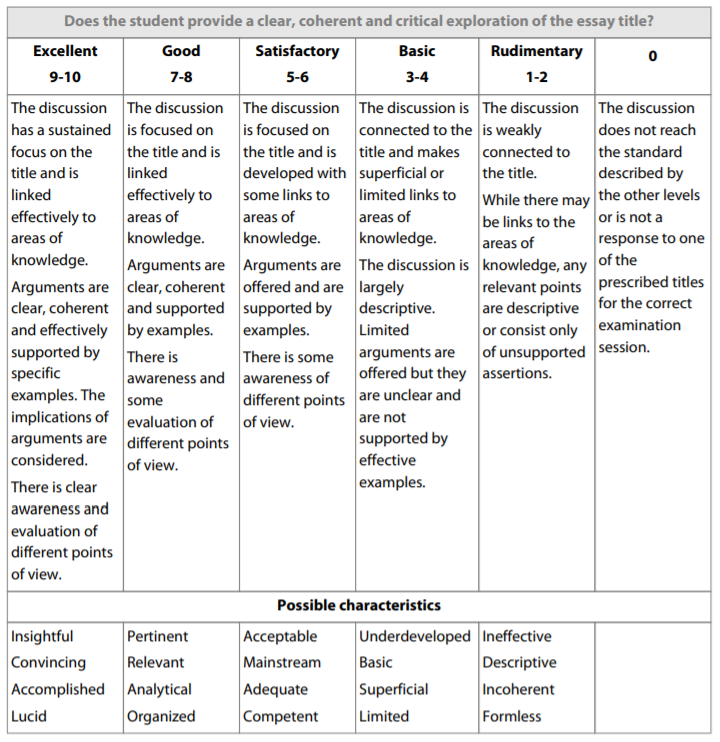
Finally, I would like to share with you a few common traits I’ve found when looking at top graded Essays. Here are some more to do’s:
- Maintain focus on the title throughout the entire Essay.
- Make links to knowledge gained in your IB subjects .
- Include some personal circumstances (briefly and where appropriate) that make you unique.
- Show international mindedness.
- Keep your examples of RLSs short
One last word of advice…
It is always a good idea to ask a friend or a family member to read your work before you hand it in. This person, an outsider who is not in your mind, can help you realize if your writing is clear, comprehensible and coherent.
Suscríbete a nuestra newsletter
The Tech Edvocate
- Advertisement
- Home Page Five (No Sidebar)
- Home Page Four
- Home Page Three
- Home Page Two
- Icons [No Sidebar]
- Left Sidbear Page
- Lynch Educational Consulting
- My Speaking Page
- Newsletter Sign Up Confirmation
- Newsletter Unsubscription
- Page Example
- Privacy Policy
- Protected Content
- Request a Product Review
- Shortcodes Examples
- Terms and Conditions
- The Edvocate
- The Tech Edvocate Product Guide
- Write For Us
- Dr. Lynch’s Personal Website
- The Edvocate Podcast
- Assistive Technology
- Child Development Tech
- Early Childhood & K-12 EdTech
- EdTech Futures
- EdTech News
- EdTech Policy & Reform
- EdTech Startups & Businesses
- Higher Education EdTech
- Online Learning & eLearning
- Parent & Family Tech
- Personalized Learning
- Product Reviews
- Tech Edvocate Awards
- School Ratings
How to Change Your Facebook Language Settings
New map app helps gearheads find the best driving roads in their area, top 10 best isekai anime to watch, best time to visit tampa (weather and costs) – goats on the road, living in the suburbs vs. the city: the pros and cons of each, 25 best satire movies of all time, ranked, 9 best post-workout habits for muscle recovery, streaming the best yule logs for a cozy atmosphere, pass on aspen: a family trip to colorado is best spent on the road, woolworths launches new cake slice range – and checkers responds inthe best way, how to write a tok essay: 15 steps.
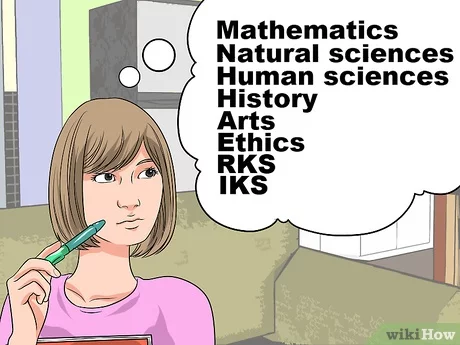
The Theory of Knowledge (TOK) essay is an important component of the International Baccalaureate (IB) diploma program. It challenges students to reflect on the nature of knowledge and how we come to know what we know. By following these 15 steps, you can craft an effective and well-structured TOK essay.
1. Understand the assignment: Familiarize yourself with the TOK essay’s purpose and requirements before you begin writing. Read through the assessment criteria offered by your teacher or IB coordinator.
2. Choose a title : Select a prescribed title from the list provided by the IB. Pick one that interests you or that you have thoughts about already, as this will make researching and organizing your ideas easier.
3. Prepare for research: Compile a list of potential sources and areas to explore in relation to your chosen title. Use prior knowledge, class notes or external resources as starting points.
4. Gather evidence: Conduct research using reputable sources such as journal articles, books, and websites. Be sure to evaluate each source for credibility and relevance to your topic.
5. Develop your Knowledge Questions (KQs) : KQs are central to a successful TOK essay. These open-ended questions help you explore different perspectives on the nature of knowledge in relation to your chosen title.
6. Create an outline : Sketch out a rough structure for your essay, listing the main arguments, counterarguments, and supporting evidence in a logical order.
7. Craft an engaging introduction: Grab your readers’ attention by explaining the importance of your topic and providing context for your discussion.
8. Develop your thesis statement: This is a clear and concise statement that conveys your main argument in response to the title question.
9. Build your body paragraphs: Each paragraph should focus on one point or argument supported by relevant evidence, examples or real-life situations.
10. Analyze alternative perspectives: Identify and explore alternative views that challenge or contradict your central argument. This demonstrates your ability to think critically and engage in open-minded inquiry.
11. Challenge your assumptions : Recognize the limitations of your own perspective and the potential biases influencing your ideas. Addressing these uncertainties strengthens the depth of your TOK essay.
12. Write a conclusion: Summarize the main points of your essay, restate your thesis, and reflect on the implications of your findings as they relate to the broader TOK themes.
13. Proofread and edit : Review your essay for coherence, grammar, sentence structure, and punctuation errors. Make revisions as necessary to ensure clarity and overall quality.
14. Seek feedback : Share your essay with teachers or peers to gain valuable feedback that can help you refine and polish your work.
15.Write a bibliography: Ensure that you’ve accurately cited all sources used throughout the essay, adhering to a consistent citation style (e.g., MLA or APA).
By following these 15 steps, you’ll be well-prepared to craft an engaging and thought-provoking TOK essay, demonstrating not only an understanding of the topic at hand but also showcasing exceptional critical thinking skills. Dive into your chosen title with confidence and curiosity!
How to Get Vivid Dreams: 15 Steps
How to do an online raffle: 11 ....
Matthew Lynch
Related articles more from author.

How to Make Toast in an Oven: 10 Steps

3 Ways to Address an Envelope to a Married Couple

How to Live Without Social Media
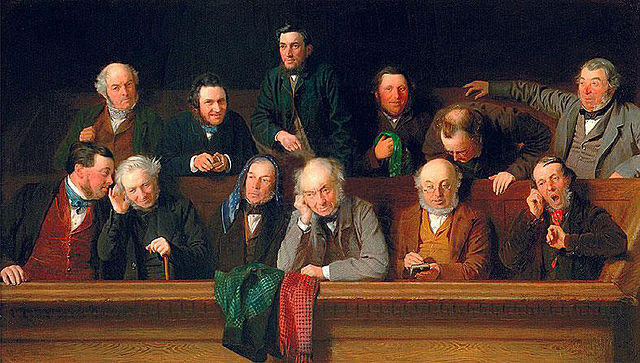
How to Get on a Jury: 9 Steps

3 Ways to Be Caller Number 10 to a Radio Station
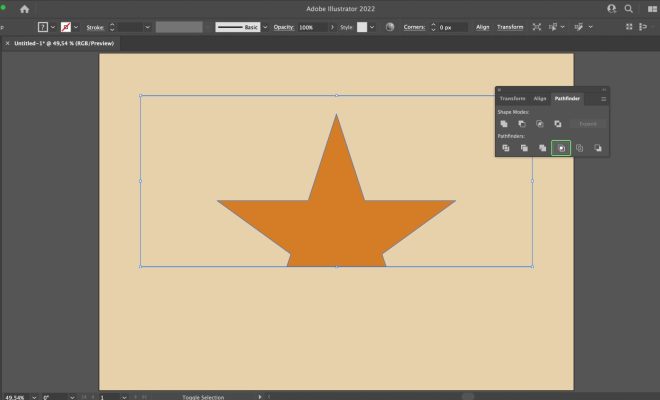
How to Crop in Illustrator
Writing & uploading the TOK essay
TOK Home > Free TOK notes > TOK essay guidance > Writing & uploading the TOK essay
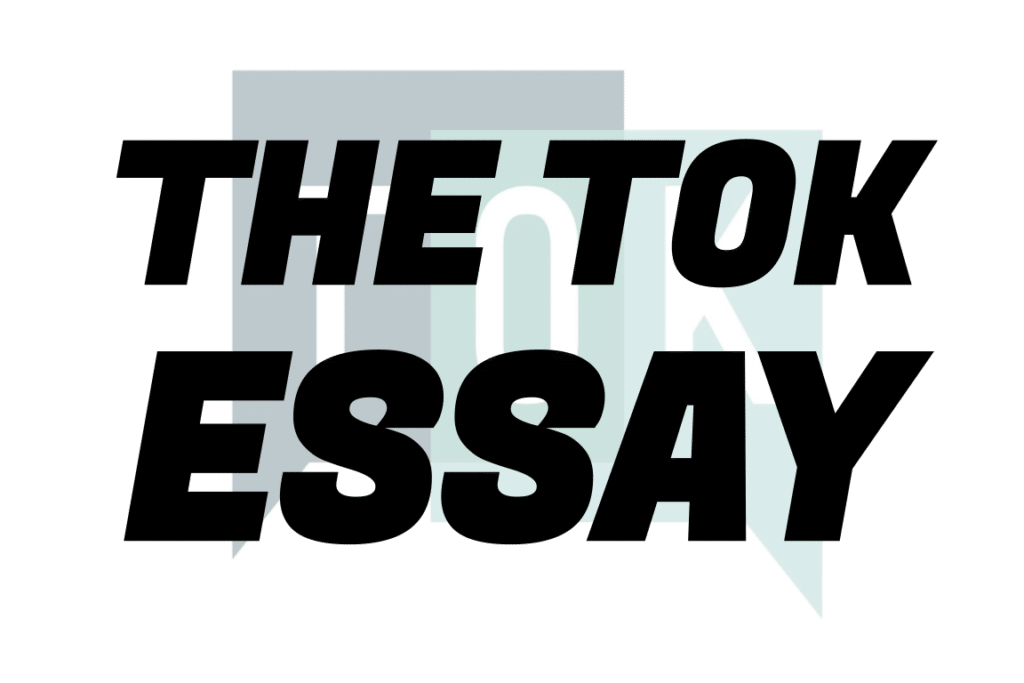
After you have grasped the essay rubric , chosen your title , and have a clear plan and structure , you can start writing your TOK essay. You’ll be doing this alongside the three interactions, so keep these in mind as you proceed.
Read the points below to get some advice on how to write your essay, and avoid common mistakes made by students.
STEP 4: Write and upload your TOK essay
Get started.
The most important part of writing your essay is getting started. You can procrastinate for ages, thinking about whether you’ve chosen the right title, which areas of knowledge to explore the question in, key thinker and ides to draw on, and so on. Obviously you need to choose the right title, and have an effective plan, but this means nothing until you have put your thoughts down on paper. You will find that many of your uncertainties start to resolve themselves when you start writing.
The introduction is all important
Your introduction should begin with a ‘hook’ to engage the reader, offer your interpretation of the key words or ideas from the title (don’t just copy a definition out of a dictionary – give your take on what the title means), outline the scope of the essay. Get your introduction right, and you will have set up the foundations for a great essay. If you rush it, or not view it with the importance it really requires, you’ll struggle to develop clear ideas in the main body of the essay.
Follow a clear essay plan
By two, you should have formulated a clear essay plan. This means knowing which AOKs you are using as the context of the essay, the arguments and counterarguments you’ll be presenting, the real-life examples you’ll be drawing on to justify discussion points, how you’ll indicate the implications of your arguments, and the way in which you’ll challenge assumptions in the question. Agree with your teacher on this plan, and let them know if you are deviating significantly from it.
Justify each point you make
Each of the discussion points you make should be supported by a real-life example. These can come from your own experiences as a knower (inside, and outside of the school), or from events, issues, and topics you’ve read about or encountered from the news and other media sources.
Don’t jump straight into your examples
A common mistake made by students is to move straight onto real-life examples without offering a proper discussion about knowledge. Discuss your own take on the question, perhaps referring to a key thinker or theory, before relating this to a real-life situation.
Consider counterarguments
You need to offer a consideration of different points of view, and the way to do this is via counterarguments. For each of your claims or arguments, you should offer a counterclaim or counterargument, weighing up how the issue could be considered from another point of view. Make sure you evaluate these counterarguments, and don’t just mention them.
Find your own voice
Make sure that you offer your own opinions, give your own interpretation of the title, and offer your own experiences to support your arguments. This will demonstrate your skills as a critical thinker, and distinguish your essay from those that rely on generic and cliched discussions.
Make full use of the interactions
In order to develop your ideas, and ensure that you’re on the right track with your essay, make sure you make full use of the with your teacher. It’s during these one-to-one sessions that you can discuss your arguments, evaluate your examples, and consider which key thinkers and concepts work in your essay.
Don’t neglect the non-assessed elements
Make sure that you format your essay in the right way, offer a decent bibliography, hit the word limit (without going over it), and follow all the other protocols for submitting your TOK essay. This will present a great impression to examiners, and show that you are ready and willing to follow the IB requirements for the assessment task.
A four-step guide to the TOK essay
Click on the buttons below to take you to the four steps of creating a great TOK essay. Don’t forget that we have plenty of videos on this and other aspects of the course, and members of the site have access to a huge amount of other resources to help you master the course and assessment tasks.
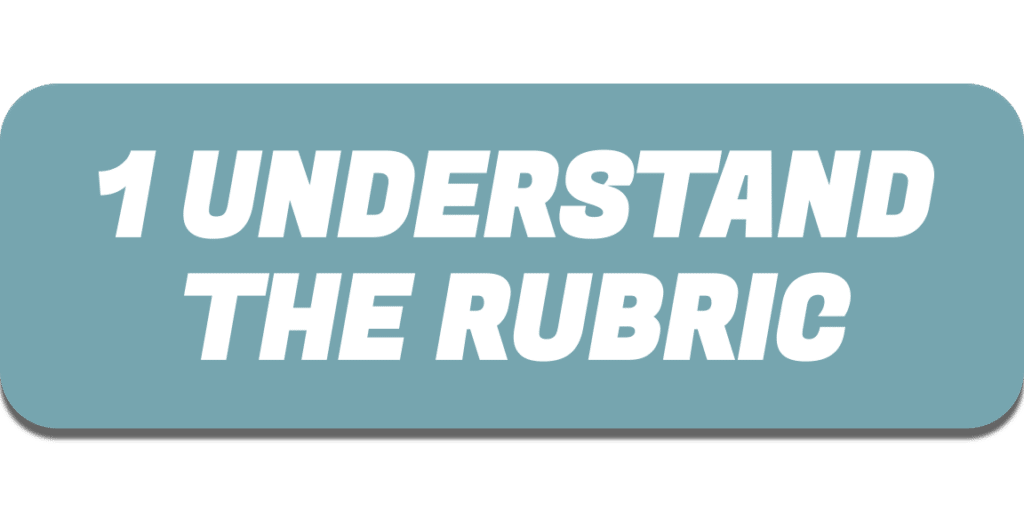
Check out our three-minute explainer video on the TOK essay here . The video goes over the basics of the TOK essay, such as how it’s assessed, the word count and other practical details, terms such as ‘perspectives’ and ‘implications’, and the role of real-world examples in justifying claims and arguments.
You’ll find more videos on this and other aspects of TOK here , and you can dive into much more depth via our free and premium webinars, here .
Watch our essay & exhibition webinars
Click on the images below to access these premium webinars on how to create the essay and exhibition. Access more webinars here , and watch our videos on the assessment tasks on this page .
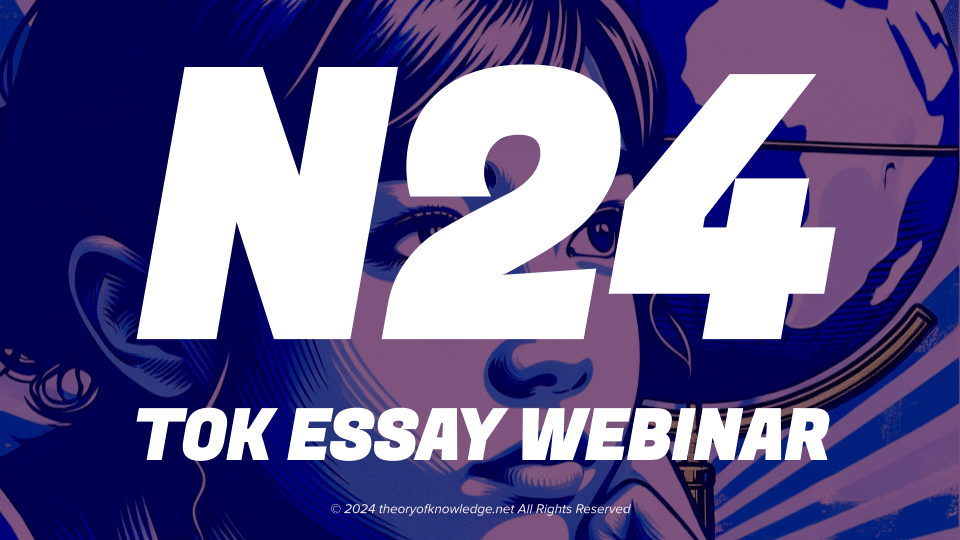
FAQs about the TOK essay
How do i choose my tok essay title.
You choose your essay from six prescribed essay titles, that are released at the beginning of your second DP year. We give a few tips on how to choose a PT that will work for you here . But briefly, choose one that links to your pre-existing knowledge, and that you find personally engaging.
What will I be writing about in my TOK essay?
You’ll be answering your prescribed title, within the context of two areas of knowledge, considering how different perspectives might affect our response to the question, and what the implications of your arguments are.
Can I use ChatGPT to write my essay?
You can use ChatGPT to help you gather materials for your essay, but you should definitely not be using it to write the essay. Be very careful with ChatGPT. It bases its answers on online material, and much of this is inaccurate or out-of-date. For example, depending on what you ask it, it may tell you that you have to explore multiple areas of knowledge (rather than the two stipulated by the titles), and that you have to identify a separate knowledge question to the title (which is absolutely not the case).
How much help should I expect from my teacher?
Your teacher should run through the PTs when they are first released, and then meet you for three interactions, during which you’ll discuss your progress. They are allowed to give you one set of written feedback. But you can consult them at other times with specific questions.
Do I need to use real-world examples in my TOK essay?
Yes, real-life examples help illustrate your points and make your arguments more tangible. They can be drawn from personal experiences, historical events, scientific discoveries, etc.
Should I include my personal opinion in the TOK essay?
While the TOK essay is not about your personal opinion per se, it’s important to reflect on your perspective and how it shapes the way you understand the title. However, you should avoid using the essay as a platform for rants or unsubstantiated claims.
Is it necessary to include counter-arguments in my TOK essay?
Yes, including counter-arguments shows a deeper understanding of the complexity of the topic and demonstrates your critical thinking skills. It also enables you to consider different perspectives, and evaluate the implications of arguments.
Should I include the 12 key concepts in my essay?
Yes, as much as you can, draw on the key concepts such as justification, evidence, perspective, bias, certainty, and objectivity within your arguments linking them to the title, and to the real-world examples you draw on.
How do I ensure that my TOK essay reflects my own original thinking, and avoids plagiarism?
Clearly attribute ideas and sources that are not your own, and strive to present original insights and interpretations supported by evidence and reasoning. See our point above on using ChatGPT – never view this as more than a tool to help you gather material for your essay, rather than a tool to write it for you.
What are some common pitfalls to avoid when writing a TOK essay?
Avoid oversimplifying complex issues, relying solely on personal opinion without justification, neglecting counter-arguments, veering off the question, and failing to include a consideration of different perspectives.
How long do I have to write my essay?
You’ll have 6 months from the time the prescribed titles are released, to the deadline date for uploading your essay to the IB. However, most schools will set their own deadline for completing the essay, so that everyone has plenty of time to complete your PPF, and upload it on time. Follow what your school tells you about this.
How important is the TOK essay PPF?
The PPF (‘Planning and Progress Form’) is the document that you fill in to outline your discussions during the three essay. Although this is not directly assessed, it is an important part of demonstrating that you have approached the TOK essay in an ethical way, which is now particularly important in the era of ChatGPT.
What are some effective strategies for revising and editing my TOK essay to improve clarity and coherence?
Take breaks between revisions, seek feedback from peers or teachers, and carefully proofread for grammar, punctuation, and coherence.
Should I include references or a bibliography in my TOK essay?
While not required, referencing sources appropriately adds credibility to your essay; use footnotes or endnotes for citations.

Subscribe to the free TOK newsletter!
Subscribe to our free newsletter, and collect fantastic examples that will help you to understand the key ideas of TOK, support your essay and exhibition discussions, and help you to become an authentic critical thinker .
You’ll encounter some of the most important thinkers from the past and the present, go beyond the headlines of contemporary events and issues around the globe, and see how TOK concepts manifest in the real-world. Subscribe HERE !

IB TOK Essay examples
Type a search phrase to find the most relevant TOK Essay examples for you
Not sure what to search for? You can always look through our example Internal Assessments below for inspiration.

All TOK Essay Examples
Filter exemplars, for artists and natural scientists, which is more important: what can be explained or what cannot be explained discuss with reference to the arts and the natural sciences., does it matter if our acquisition of knowledge happens in "bubbles" where some information and voices are excluded discuss with reference to two areas of knowledge., want to get full marks for your tok essay allow us to review it for you 🎯, is replicability necessary in the production of knowledge discuss with reference to two areas of knowledge., are visual representations always helpful in the communication of knowledge discuss with reference to the human sciences and mathematics., fast track your coursework with mark schemes moderated by ib examiners. upgrade now 🚀, to what extent is the knowledge we produce determined by the methodologies we use discuss with reference to history and one area of knowledge., tok essay: 5. “how can we distinguish between good and bad interpretations discuss with reference to the arts and one other area of knowledge”, 如果我们是在排除某些信息和声音的“信息同温层”里获取知识,这有关系吗请参考两个知识领域展开你的应答。, does it matter if our knowledge acquisition happens in "bubbles" where some information and voices are excluded discuss with reference to two areas of knowledge., is replicability necessary in the production of knowledge discuss with reference to two areas of knowledge, do you agree that it is “astonishing that so little knowledge can give us so much power” (bertrand russell) discuss with reference to the natural sciences and one other area of knowledge., does it matter if our acquisition of knowledge happens in “bubbles” where some information and voices are excluded discuss with reference to two areas of knowledge., to what extent is the knowledge weproduce determined by the methodologieswe use, for artists and natural scientists, which is more important: what can be explained or what cannot be explained discuss with reference to the arts and natural science., êtes-vous d'accord qu'il est "étonnant que si peu de connaissance puissent nous donner autant de pouvoir" (bertrand russell) - discutez cette question en faisant référence aux sciences naturelles et à un autre domaine de la connaissance, est-il important que notre acquisition des connaissances se fasse dans des « bulles » où certaines informations et certaines voix sont exclues discutez cette question en faisant référence à deux domaines de la connaissance., to what extent is the knowledge we produce determined by the methodologies we use discuss with reference to history and one other area of knowledge., is replicability necessary in the production of knowledge discuss with reference to two area of knowledge, are visual representations always helpful in communicating knowledge discuss with reference to the human sciences and mathematics., are visual representations always useful in communication of knowledge discuss with reference to the human sciences and mathematics., for artists and natural scientists which is more important: what can be explained or what cannot be explained, is replication necessary in the production of knowledge discuss with reference to two aoks., do you agree that it is "astonishing that so little knowledge can give us so much power" (bertrand russell) discuss with reference to the natural sciences and one other area of knowledge., is replicability necessary in the production of knowledge.

How To Write a ToK Essay IBDP – Step-By-Step Guide
Shamim imtiaz.
- Created on March 10, 2019
- Blog , IBDP , Learning Tips

Let’s learn how to write a ToK Essay with Tutopiya. The IB ToK Essay contributes to the overall score of a student’s IB Diploma. The award of points for the IB ToK Essay is in conjunction with the extended essay. A maximum of three points is awarded according to a student’s combined performance in both the TOK and Extended Essay.
Tutopiya will help and guide our IB Diploma students on the following:
– How to Start a ToK Essay
– Cover the ToK Essay Structure
– How to Write a ToK Essay Conclusion
– Analysis of a ToK Essay Example

Choosing Your Essay Title
Before you can dive into structuring or writing your essay, you will need to spend time to decide on a topic you wish to write on. For the IB ToK Essay, you are required to compare and contrast different ways of knowing through perception, language, reason, emotion with different areas of knowledge (AOK).
1 – Selecting your prescribed title and knowledge question
Before you hastily decide on a title you wish to write, take some time to read each title carefully on the list and brainstorm ideas.
Tip #1: Brainstorming
Get some initial ideas you have of each and every title/ question down on paper. Ask yourself some simple questions when brainstorming for each title.
Am I confident to write an essay about this? Is the question asking what I am thinking? Do I understand the keywords or concepts in the title?
You may not be clear on what the title is asking you to do. Go through the title and highlight any keywords and concepts you are unsure about or may have missed out.
Do you have a strong interest in the title? We recommend that you should at least be interested since you will be spending time and effort on researching this topic, pick something you are willing to research more about!
Can you relate anything to the title? Though the IB Tok Essay should be as objective as possible, you can always inject the essay with personality and character.
You can always do so by adding in ideas or topics you have learned or studied in class or even personal experiences.
Tip #2: Understanding the question in your own words
The titles of these essay questions can sometimes be long and difficult to grasp when you first read them so before you write the IB ToK Essay, consider paraphrasing the question in your own words.
You may struggle to understand the keywords and concepts in the title, you may even be unsure about the perspective, comparison and contrast of the title.
To help our IB students, we recommend breaking down the question/ title by first, understanding the keywords in the title. Then, put the title together and understand what they are asking.
This way, you will be able to understand the title more in-depth than before and able to answer the title sufficiently.
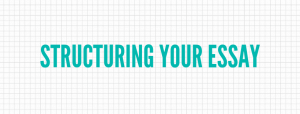
Structuring your Essay
1 – knowing the assessment criteria .
Overall Assessment
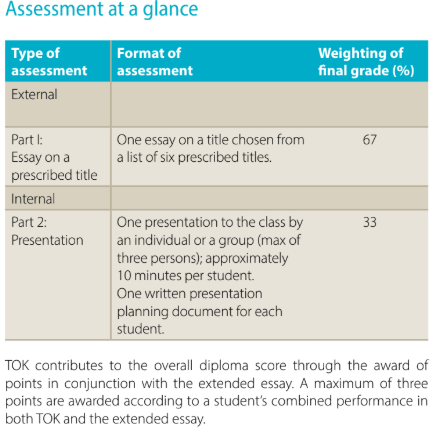
2 – Theory of Knowledge Essay
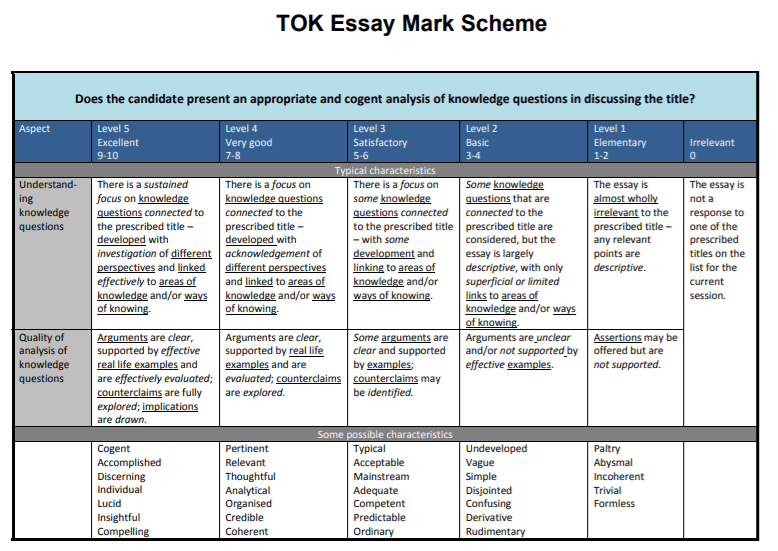
The rubrics require students to be able to understand the knowledge questions and their quality of analysis of knowledge questions. View the TOK Essay Mark Scheme here .
You will have to choose two Areas of Knowledge (AOK) to explore.
There are 8 different Areas of Knowledge are as follows:
1 – Mathematics
2 – Natural Sciences
3 – Humane Sciences
4 – History
5 – The arts
6 – Ethics
7 – Religious knowledge systems
8 – Indigenous knowledge systems
You can also use Ways of Knowledge (WOK) in your essay and they are as follows:
– Emotion
– Faith
– Sense Perception
– Reason
– Imagination
– Intuition
– Language
– Memory

Analysis of a Sample Essay
Question: “Doubt is the key to knowledge (Persian Proverb). To what extent is this true in two areas of knowledge?
Important Keywords in the Title
“To what extent”
When keywords like this appear, note that you need to present 2 different perspectives to the question, a for and against argument in your essay.

Paragraph 1: Introduction
You would provide an explanation and interpretation of the title and identify the key terms in the title. You would also need to state your thesis and explain or identify the areas of knowledge you will be exploring in your essay.
1 – Start the essay by saying something relatable or interesting
By doing that, you can capture the reader’s attention and make them want to read more by evoking a sense of curiosity to find out more about your essay.
2 – Your Thesis/ Stand
You can also state your thesis (that is different from mainstream ideas – to capture the reader’s attention). You can make the decision to be a for or against stand in your essay. If you decided

In your own words , give an interpretation of the title and show that you are able to identify the key terms of the question.
“The problem with doubt as the key to knowledge is that doubt isn’t a way of knowing. Doubt is an emotion we feel that motivates us to seek knowledge.”
3 – Outline of the paragraph
Give the readers an idea of what you will be going through in your body paragraphs , a sentence that gives the readers a preview. Let the readers know which AOKs you will be exploring, making it easier for the examiner to know what to look for.
“However this motivation can manifest itself differently in contrasting areas of knowledge like Mathematics and Religion.”
Your introduction should not be too long, use around 150 to 200 words for your first paragraph would be sufficient.

Paragraph 2: First Area of Knowledge.
1 – begin your paragraph with a claim or topic sentence.
This helps you to outline your argument about the title.
“Mathematics is an area of knowledge that is only concerned with reason.”
2 – Explain and Elaborate
Now, give explain and elaborate on your topic sentence/ claim.
“In a right-angled triangle a²+b²=c² and that’s it. There are no alternative answers or personal interpretations. An answer to a mathematical problem is either right or wrong. This is because the main way of knowing in math is reason and evidence is required for a mathematical statement to be true or false.”
3 – Give an example with an explanation
This helps you to further elaborate and explore your topic sentence or claim.
The example you give should be personal, specific, precise and real.
This way you can make your claim believable and relatable in some sense. This also helps to evoke a sense of authenticity in your essay.
“When we first learned about negative numbers in math class it made no sense to me. How could a bigger number have a lower value than a smaller one? It was illogical and it contradicted all the math I had learned before that day….. Either the previous mathematical information was wrong or the new information about negative numbers were wrong. But he explained the concept of a number line with a central point 0 and that they were both right.”
4 – Linking back
Remember to link back to your claim and the question after you are done exploring this example.
“My doubt led to understanding and was the key to my knowledge.”

Paragraph 3: Counter
1 – state your counterclaim.
This paragraph would focus on counterclaims . You are supposed to discuss 2 different perspectives to your claim, a for and against. You are to argue against your claim above this paragraph.
“On the other hand, doubt in mathematics can be detrimental to education.”
2 – Give an Example and Explanation
Add in an example and explanation to support your counterclaim.
“For example, after I do a question from the International Baccalaureate mathematics textbook I always look at the back in order to check if my answers are correct because it has answers in the back. If I do not have the book and I am in class then I ask my mathematics teacher for the correct answer. I do this when I am uncertain of my answer to a question and my doubt allows me to gain knowledge i.e. whether my answer is wrong or right. My doubt also helps me to assess how much of the mathematical concept I have understood by marking myself. However, this can be detrimental to progress because I started to become dependent on the answers at the back of the book or my mathematics teacher. Every time I do a question I feel like I have to verify my answer with an authoritative source which I have now come to understand leaves no room for exploration or the development of my own methods.”
3 – Linking back
Link back to your prescribed title and your claim of this paragraph.
“My doubt caused a loss of confidence in my mathematical abilities and dependence on authoritative sources.”
Now, follow this format and carry on writing for the next two body paragraphs, exploring on another Area of Knowledge, in this case, this student will have to write one more AOK on Religion and a counterclaim for it.
Aim to write a maximum of 600 words for each Area of Knowledge (Paragraph 2 and 3, Paragraph 4 and 5).
Paragraph 4: Second Area of Knowledge
– Topic Sentence
– Explain
– Example + Explanation
– Link
Paragraph 5: Counterclaim
- Topic Sentence (Counterclaim)
- Example + Explanation
- Link to prescribed title and your initial claim of this Area of Knowledge
Finally, write your ToK Essay conclusion in one paragraph totalling 200 to 250 words .

Paragraph 6: Your conclusion
Explain the different insights you have gained or have come out of this essay.
“As illustrated by the example of dependence on authoritative sources in mathematics doubt can be detrimental and cause a loss of confidence. Similarly, doubting conjectures has also proven to be unfruitful. However, within mathematics individual doubt can lead to the acquisition of knowledge.”
Implications and significance
Tell the readers why it is important to know that and how does it matter that they understand this when you write your IB ToK Essay.
Perspectives and Extension
If you can, try to input a very different perspective on your conclusion. Perhaps recognizing a different way of approaching the question, which could have resulted in different insights.
You can mention the limitations of your essay saying there are one or two unresolved questions that this essay has revealed. It’s about showing the readers that the conversation is not over yet. And that, there is more to the question and more rooms that you can explore.
“Furthermore, in areas like religion where we do not yet have the tools to prove it one way or the other simply doubting something by itself is a step towards acquiring knowledge because by suggesting that certain view is not absolute it makes room for new knowledge.”
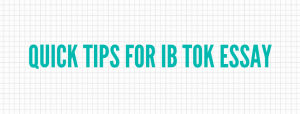
A Quick Tip for writing a ToK Essay
Tip: try not to use dictionary definitions in your essay.
You want to show the examiners that you are writing a reflective essay, not a textbook definition heavy essay. Don’t rely too much on dictionary definitions to prove your argument or support a counterclaim. This will demonstrate that you did not engage with the topic and bypassed complexities around the topic.
Instead of using standard answers or cliche examples, you can try to use your own personal experiences to make it original and insightful for your readers. Though the essay should be objective, your essay should still have a personality and character.
Try Getting Expert’s Help
Tutopiya is a 1-1 Live Online Tutoring for all students aged 8 to 18 years old. Tutopiya offers the IB Diploma Programme curriculum to all students, visit our IB curriculum page to find out more about the subjects we teach here. We also have a blog full of useful IB resources for our students, why not read another sample essay for IB TOK ?
Interested to try our online learning with our expert IB tutors? We provide FREE 60 minutes trial lessons to all new students. You can sign up or simply fill up a trial form application here to begin learning with Tutopiya! Come learn how to write a ToK essay with Tutopiya today!
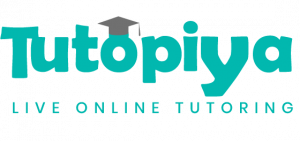
See author's posts
Recent Posts
- Empowering Minds: The Inspiring Journey of Fathima Safra Azmi
- Mastering IGCSE: Ace Your Exams in 3 Months with Our Unlimited Learning Program
- IGCSE Exam 2024 Revision: 10 Tips and Tricks to Score A*
- How to Ace Your IGCSE Exam in 3 Months: A Comprehensive Guide to Score A*
- Tutopiya’s Shining Star: An Insight into the Teaching Journey of Anshu Gupta
- IGCSE Group Classes in Singapore: Exam Preparation, Pricing, Benefits and Online Resources
- 1:1 IGCSE Online Tutoring in Malaysia: Benefits, Challenges, Online Resources and How to Succeed
- IGCSE Mock Assessment: Prepare with Tutopiya’s Practice Exams
- IGCSE Online Tutors Dubai: Boost Your Grades Now
- How to Stay Calm and Confident in IGCSE Exams
Get Started
Learner guide
Tutor guide
Curriculums
IGCSE Tuition
PSLE Tuition
SIngapore O Level Tuition
Singapore A Level Tuition
SAT Tuition
Math Tuition
Additional Math Tuition
English Tuition
English Literature Tuition
Science Tuition
Physics Tuition
Chemistry Tuition
Biology Tuition
Economics Tuition
Business Studies Tuition
French Tuition
Spanish Tuition
Chinese Tuition
Computer Science Tuition
Geography Tuition
History Tuition
TOK Tuition
Privacy policy
22 Changi Business Park Central 2, #02-08, Singapore, 486032
All rights reserved
©2022 tutopiya
- International
- Schools directory
- Resources Jobs Schools directory News Search

November TOK Essay Titles Unpacked.
Age range: 16 - 18
Resource type: Lesson (complete)
Last updated
23 March 2024
- Share through email
- Share through twitter
- Share through linkedin
- Share through facebook
- Share through pinterest

This is a 42 page TOK resource which contains the following:
detailed mind maps of November 2024 Essay titles with brief summary. detailed template to help organise each Essay title.
list of TOK vocabulary with their definitions .
This is a very detailed resource to help teachers prepare their students unpack the essay titles and start writing them. The mindmaps are very useful in helping the teachers and students get a prespective on the Essay title and spark off new ideas. n unpacking November’s Theory of Knowledge (TOK) titles, it’s crucial to deconstruct each prompt methodically. Utilize a templated approach, breaking down each title into its key components: identifying the knowledge questions, clarifying key terms, and recognizing the underlying assumptions. Mind maps can aid in visualizing connections between concepts and exploring diverse perspectives. When approaching a title, consider multiple knowledge perspectives, such as areas of knowledge and ways of knowing. Evaluate the implications of different interpretations and methodologies, fostering critical thinking and reflection. By systematically analyzing each prompt and constructing coherent arguments, TOK students can effectively engage with the complexities of knowledge claims.
Tes paid licence How can I reuse this?
Your rating is required to reflect your happiness.
It's good to leave some feedback.
Something went wrong, please try again later.
This resource hasn't been reviewed yet
To ensure quality for our reviews, only customers who have purchased this resource can review it
Report this resource to let us know if it violates our terms and conditions. Our customer service team will review your report and will be in touch.
Not quite what you were looking for? Search by keyword to find the right resource:

IMAGES
VIDEO
COMMENTS
Paragraph 1. - Say one or two interesting things about the prescribed title question. This shows us, right away that you know what the question is asking. - Define one or two of the key terms in the title. Get definitions for all of the main words in your title. You don't need to include all of them in your essay, but it's useful to see how ...
Download Article. 1. Use your essay outline as a guide. Focus on expanding each section of your outline, keeping in mind the 1200-1600 word limit for the essay. Your introduction and your conclusion should be the shortest paragraphs in your essay, and the body paragraphs should be the longer sections of your essay.
Introduction. Introduce your topic accurately and state your thesis statement for the essay carefully. A thesis statement is like a teaser to your entire essay wherein you define your key terms and introduce your interpretation of the question. Make sure that you do not reword the prescribed title in your thesis.
The TOK essay is a 1600 word essay written about topics usually given to students from their teachers from a list of numerous options. It is an essay that promotes arguments and counterarguments for the topic at hand. Understanding your ways of knowing (WOKs) and areas of knowledge (AOKs) is extremely crucial before you even start choosing a ...
Tip #2: Understanding the question in your own words. The titles of these essay questions can sometimes be long and difficult to grasp when you first read them so before you write the IB ToK Essay, consider paraphrasing the question in your own words. You may struggle to understand the keywords and concepts in the title, you may even be unsure ...
10 TOK essay starting points. 1 The TOK essay is an individual task. 2 It represents two thirds of the overall mark for TOK. 3 It is externally marked. 4 You choose your title from a list of six prescribed titles, which change every exam session. 5 The word count for the essay is 1600 words.
Overview of TOK Essay strategy. Here are the six cumulative sections: Unpack your prompt. Reconnect with the 5 Areas of Knowledge. Focus on your essay format. Using the TOK Framework to refine your planning. Returning to the Rubric. Finessing the quality of your analysis.
Further guidance on the TOK essay and exhibition can be found in the IB's Programme Resource Centre (PRC). Materials in the PRC are only available to existing IB World Schools. These materials are free. There are a number of resources on TOK in the IB Store, which are available to everyone. Find out how to become an IB World School.
The title of your TOK essay is more than just a starting point; it's the framework upon which your entire argument is built. Take the time to choose wisely, and ensure it's a title you can engage deeply and critically. This careful consideration at the beginning significantly affects the ease of writing and the quality of your final essay.
Three mandated formal interactions between the student and teacher are recorded on the Planning and Progress Form (TK/PPF): 1. Discuss the list of prescribed titles with the student. 2. Discuss the student's initial exploration of their selected title. 3. Comment on one draft of the student's essay.
Unpacking the Prescribed Title (PT) in the Introduction: Offer your interpretation and explanation of the essay question here. For a more detailed exploration, refer to my e-book, "How to Write the ToK Essay in 6 Easy Steps" linked here. Common ToK Essay Structure. A widely used structure, found in about 75-80% of ToK Essays, looks like this:
The TOK essay has a distinct structure that should be followed throughout the paper. The basic structure includes an introduction, body paragraphs, and a conclusion. Each of these parts should be a separate section within the outline and should include specific points.
Discover how to write a compelling ToK Essay Introduction. Learn what to include and avoid for a strong start to your Theory of Knowledge essay.For more info...
Once you've grasped the essay rubric, and chosen your title, you can start planning and structuring your TOK essay. You base this around the 3 interactions with your teacher, which are one-on-one meetings discussing your progress, and receiving feedback. As well as the interactions, you can also ask your teacher specific questions about your ...
A quick overview of the ebook How to Write The ToK Essay in 6 Easy Steps.If you need a bit of extra help with the IB Theory of Knowledge Essay you can pick t...
Watch this video and download a template that teaches 3 different ways of starting your Theory of Knowledge essay! If you want to know how to write an introd...
You can start by putting time into your weekly schedule to work on your ToK essay, if you give yourself 2-3 months to complete the essay you will probably only need to put 30mins-1hr / week into your schedule to successfully finish the essay. You should plan backwards from the Draft Deadline (remember the Draft Deadline should always be treated ...
Before we jump into the do's on "how to write the perfect TOK Essay", let's start with the most important don't: Whatever you do, do not google the prescribed titles as soon as you read them to have someone else unpack them for you.. I'm not saying you shouldn't, I'm saying that it should not be the very first thing you do.
Use prior knowledge, class notes or external resources as starting points. 4. Gather evidence: Conduct research using reputable sources such as journal articles, books, and websites. Be sure to evaluate each source for credibility and relevance to your topic. 5. Develop your Knowledge Questions (KQs): KQs are central to a successful TOK essay ...
Writing & uploading the TOK essay. After you have grasped the essay rubric, chosen your title, and have a clear plan and structure, you can start writing your TOK essay. You'll be doing this alongside the three interactions, so keep these in mind as you proceed. Read the points below to get some advice on how to write your essay, and avoid ...
TOK Essay C. For artists and natural scientists, which is more important: what can be explained or what cannot be explained? Discuss with reference to the arts and the natural sciences. TOK Essay A. Fast track your coursework with mark schemes moderated by IB examiners. Upgrade now 🚀.
TOK Essays, can't live with them, can't live without them. Mr. John Hellner is a really experienced TOK Teacher who was kind enough to do this video (more vi...
Tip #2: Understanding the question in your own words. The titles of these essay questions can sometimes be long and difficult to grasp when you first read them so before you write the IB ToK Essay, consider paraphrasing the question in your own words. You may struggle to understand the keywords and concepts in the title, you may even be unsure ...
This is a 42 page TOK resource which contains the following: detailed mind maps of November 2024 Essay titles with brief summary. detailed template to help organise each Essay title. list of TOK vocabulary with their definitions . This is a very detailed resource to help teachers prepare their students unpack the essay titles and start writing ...
The use of abbreviations has gone too far. O n MARCH 28TH Sam Bankman-Fried was sentenced to 25 years in prison for fraud in the collapse of his crypto exchange. One particularly undignified ...